For Digital Marketers & Business Leaders
Online community managementYou're an organizational leader or digital marketer who believes they want to build an online community to grow your business -- or you're thinking about it -- but you need more information on the why and the how of creating and managing branded communities online.
(If that's you, you're in the right place...)
By the end of this guide, you'll know exactly how to create your own online community of prospects, customers, and brand superfans.
Stephanie absolutely loves connecting with people and building relationships. She has been using HubSpot for more than six years across a variety of industries on the client and agency side. Stephanie is also a co-leader of the Chicago HubSpot User Group. She is a Carthage College graduate with a B.A. in public relations and German. She also owns a highly-coveted HubSpot bicycle! You can catch Stephanie co-hosting The IMPACT Show or engaging with our community in IMPACT Elite, our exclusive Facebook group for the brightest minds in inbound and digital marketing.
Fill out the form for a downloadable PDF version of the guide you can reference later.
Introduction
When I first started to realize I was queer, I desperately wanted to find more people like me. This was not because I wanted more "gay friends." I had a great group of friends who were very supportive.
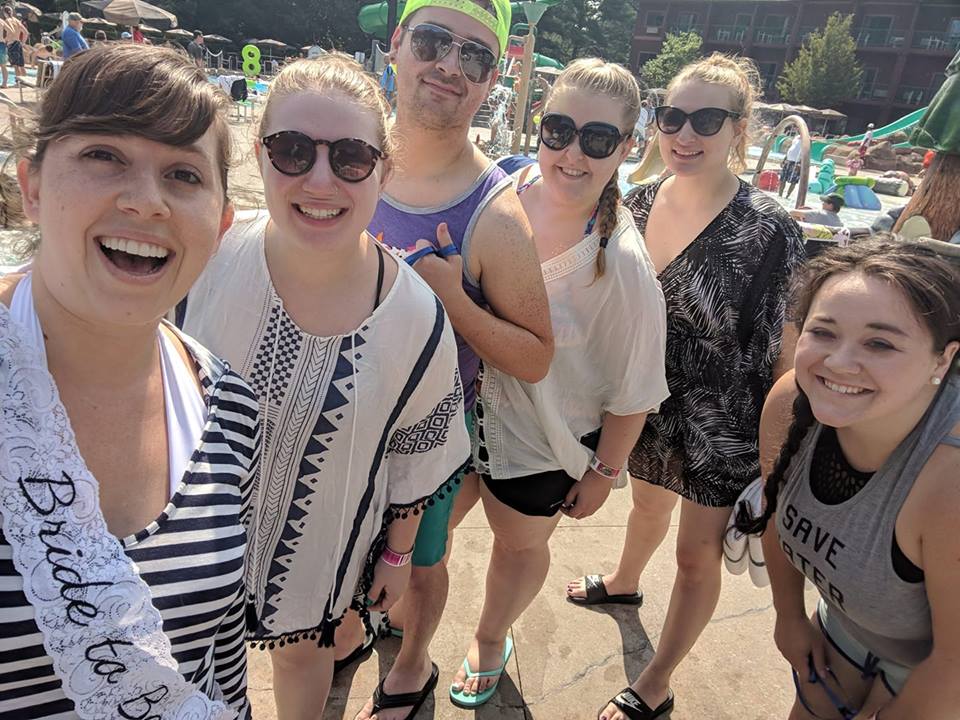
(That's me on the left!)
However, as anyone who has ever "come out" will tell you, you don't come out just once. You do it again and again and again.
When you get a new job, at family events, when you join a new club, and in so many more situations. This shouldn't be necessary but... here we are.
I wanted to find people like me because this journey was all new to me and I felt lost. I had so many questions.
I wanted support.
I wanted guidance.
I wanted to know that I wasn't alone.
I wanted to see others who had gone before me and set an example I could follow. I wanted to be able to ask questions and to know that there were people out there who had answers.
Long before officially coming out to my friends and family, I watched queer YouTube vloggers (video bloggers) and web series, joined online discussions, spent hours on Tumblr, and slowly began to find more people like myself.
These communities taught me how to explain that I'm not just gay, but that I do not consider gender a factor in attraction to people. They also taught me how to respond when people have no idea what that means.
The queer community showed me I was part of something bigger than myself and that there was support out there. There was a place to ask questions and not feel stupid. There was a place to share these unique experiences and learn from one another.
As humans, we have this innate desire to belong. To be part of something.
In fact, it used to be essential to our survival that we establish social bonds with others as a form of protection. Our need to be connected is as essential to our emotional and physical wellbeing as food and safety.
If we don't work together, we don't survive.

"It was not possible to defeat a Woolly Mammoth, build a secure structure, or care for children while hunting without a team effort. It’s more true now than then. Our reliance on each other grows as societies became more complex, interconnected, and specialized."
As Pamela says, we're all responsible for more specialized and complex things as society grows. Communities give people a place to go to unite with others around a shared interest and find support in a collection of people who understand them.
Organizations -- B2B, B2C, nonprofits, and everything in between -- that create revenue-generating online communities successfully build trust with their fans, clients, and prospects by deepening those relationships and providing genuine value.
No matter what space or industry your brand calls home, know this is possible for your company -- you can create an online community that helps you grow your business while also creating a meaningful online space for the people you want to bring together.
Chapter 1
An online community is a collection of people with a common interest coming together in a dedicated online space for a specific purpose. That's a simple enough definition but creating and maintaining an online community is much more complex. It helps to look at what an online community is not.
An online community is not just a place for customer support.
Sure, there are many branded communities that address customer support issues in them and it can help bring support issues to the surface more efficiently. However, you should not develop your community with this as a primary goal.
A community is also not a place for you to promote your organization.
Just because you run the place doesn't mean you are exempt from the rules you expect the rest of your community members to follow. If anything, you want to be the shining example of what a great community member looks like.
You also want to encourage all members to post, share, and ask questions freely. If you start to see more than two posts in a row from yourself without anyone in between, it's time to take a step back.
Finally, an online community is not something that will grow and flourish on its own. While a community may arise spontaneously, to thrive it must be nurtured with passion and coordinated, intentional actions.
Communities that exist (or at least extend) online allow us to connect to anyone, anywhere, at any time.
The beauty of the internet is that we're no longer bound by our physical location, time and schedule, or even the pressures of social anxiety. (Hello, Tumblr in bed with my dog, am I right?)
An online community is accessible and approachable.
A great example of translating in-person events to an online community is FlipMyFunnel.com -- a community that started offline and became something that exists and thrives online.

"It really started as events. What we realized is that events can only get you so far in terms of reach, in terms of the people that you're going to reach. We really started to hone in on our digital property and we built FlipMyFunnel.com."
In an online community, members can even multitask by commenting back and forth on a discussion or watching a live broadcast while doing other things.
This just isn't possible (or is very rude when it is) in an in-person setting. An online community lends itself to a slower pace and less pressure to respond immediately. This often leads to more in-depth discussion and the sharing of helpful resources.
Before we go any further, let's get aligned on the difference between an audience and a community.
Expert Interview:
When I joined the team at IMPACT, Bob Ruffolo (our CEO) suggested I help come up with my official job title. We tossed around a few ideas but kept coming back to two words: audience and community.
We discussed how these words were similar and, more importantly, how they were different. Eventually, after discussing my intended roles and responsibilities, as well as how we'd measure success in my role, it became very clear.
My job title had to include both words.
This is because an audience and a community are two very different, albeit closely related, things.
We settled on "Director of Audience Engagement and Community" because it encompassed the part of my job that spends time on our audience -- i.e., our contact database -- and the part that makes sure people have a great time at IMPACT Live, and manages and grows our communities.
So, what's the difference between audience and community, and why were we so adamant that my title included both terms?
Both your audience and your community comprise a group of people who care about what you're doing. This might include your customers, ideal prospects, team members, and key stakeholders. However, the key differences appear when you look at how you communicate with each group, and how you track and measure your interactions with them.
An audience is the group of people who consume your content, independently. You refer to them as a group but they are a group of individuals who are not necessarily aware of one another. When you refer to your audience you may speak in terms of the size of your subscriber base or the number of followers you have.
Maybe you've created personas to help segment your audience and provide more personalized content. Having a better understanding of specific segments of your audience will definitely help you connect with them and provide a lot of context for your marketing. However, an audience is simply a group of people.
A community takes the one-way nature of talking to your audience and turns it into a two-way conversation. Actually, it turns it into a multiway conversation. Your community responds to you but also starts to converse and form bonds with one another. While your audience is focused on you and what you have to say, your community is focused on engaging with you and with each other.
Community goes far beyond having subscribers to your content who read it when you send it.
A community is a living, breathing entity. It's a collection of people connecting through a shared interest on a common platform, engaging in a back-and-forth dialogue. When the people in your audience come to a specific place to engage in a discussion about a topic of collective interest -- and do this consistently -- that’s a community.
While your audience may listen to what you say -- they don't feel connected to everyone else who is also listening to what you say. Community brings these people together to form a shared identity.
I like to think of it like this:
So, now that we're on the same page about the difference between an audience and a community let's take a look at how online communities came to be what they are today.
Online communities are really not that new.
In fact, people have been collaborating, sharing, and learning from each other online via community spaces since the 1970s. And we've had in-person communities since, well, forever.
During the Great Blizzard of 1978, Ward Christensen and Randy Suess launched a public, online "bulletin board" system which laid the foundation for today's online communities. The story goes that Ward was trapped in his home in Chicago during the blizzard which sparked his idea to create an online version of the community bulletin boards that lived in libraries, schools, and coffee shops around his neighborhood.
A few years later, in 1985, another one of the first full-blown virtual communities (also the oldest still running one) was launched. It's called the WELL, which stands for Whole Earth 'Lectronic Link and it's basically a 1980s version of Reddit (founded 20 years later, in 2005).
Because of dial-up internet and slower computers, the WELL was -- and still is -- very basic, containing no advertisements or even images. (Must be nice, right?)
It's been nearly 15 years since Reddit launched, and now there are literally billions of online communities in existence. From neighborhood watch groups and online gaming groups to branded communities run by for-profit organizations, the reach of online communities is far and wide.
In this guide, I'll specifically be looking at how a business can leverage an online community.
When I was planning my wedding I joined many bride-to-be groups and I'm currently a member of online communities for things like spouses of police officers and owners of golden retriever mixes. These groups are great, but they're not the kind I'll be addressing in this guide.
But, right now, there's a good chance you're wondering:
"Stephanie, what are the benefits of us building and maintaining an online community for our company?"
Chapter 2
An online community can generate new leads, improve customer retention, and give you deeper insight into your audience:
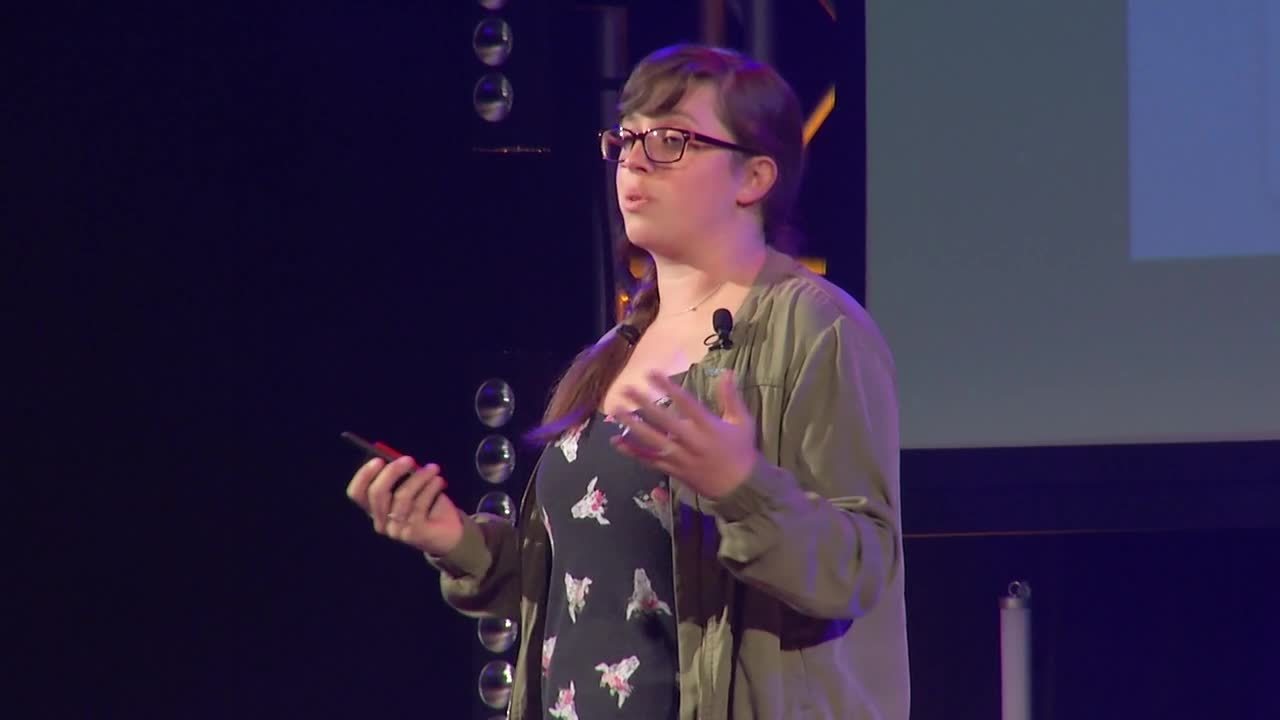
Watch me talk about building and maintaining an online community at IMPACT Live '18.
Through a community, members are able to tap into a group of individuals who have this common interest. They can get perspectives from people outside of their typical sphere of influence and can even learn from the mistakes of others without having to make them for themselves. (I learned not to come out to my whole family via skywriting...not that I was considering that, I swear.)
In an article published on LinkedIn, Mighty Networks Founder and CEO Gina Bianchini said:

"In 2019, if you are looking to attract -- and more importantly, keep -- an audience with your content alone, you will fail. Rather, the savviest digital media startups aren’t just telling fantastic stories, they are building a community they control right off the bat. When done right, a community [now] has all the characteristics of Facebook in the early days: It’s a network with better attention economics than what an audience alone can ever provide."
Gina really hit the nail on the head when she said, when done right, a community is a "network with better attention economics than what an audience alone can ever provide."
Members come to a community intentionally, it's not something that happens by accident or haphazardly. Because of this, community engagement rates are much higher than organic social media or even that of emails. When members are engaged in a community they are building relationships with each other as well as the organization hosting the community.
As members begin to consistently return to the community the relationships deepen which promotes current customer retention and even creates new opportunities for lead generation.
According to a survey by ReferralRock, a company’s community is the most valuable asset beyond the revenue they directly provide.
The constant spread of misinformation, especially online, has eroded trust in brands. This is unfortunate for businesses because trust is a vital component of a consumer's decision process -- which means, at the end of the day, we're all in the business of trust, regardless of what industry we're in.
Yet 65 percent of consumers don't trust advertisements, 71 percent do not trust sponsored social media ads, and needless to say, most rarely trust salespeople.
Since modern customers rely much more on third-party review sites, referrals from friends, and their own internet research, customers need you a lot less than they used to. They prefer to learn from their own trusted sources and would rather help themselves than ask you for help.
If your community becomes a trusted source of helpful information and includes testimonial content from real customers -- it's a place where you can earn new business.
The organization hosting the community is seen as a trusted source for answers and, when the time comes, people want to do business with people they trust.
Plus, even if community members aren't necessarily a good fit for your business, if they get value from the community, they will recommend you to others in their network.
A community is also a great place to give a select segment of your audience a behind-the-scenes look at your organization, to deepen your relationship and further build trust, without putting the information out for the entire world to see.
One online community I'm a member of (and love) is the Facebook group for users of the popular audio fitness app Aaptiv.
I spoke with Aaptiv Manager of Member Experience Maya Hutchinson about their online community. Maya explained how the group is not just a tool for the company, it's also a way to add value for the members:

"We see this group as a major perk for our paying members. It's basically a 35,000 [person] focus group, which helps them and us! They get updates from HQ first, we do monthly challenges, games, giveaways, etc., and they get direct access to our trainers who are extremely active in the page."
Having direct access to team members is a huge added benefit of a community that can really make members feel like they're part of something valuable. The more tied to a community someone is the more tied they'll be to the organization.
Building an online community is the most effective and scalable way to build an emotional connection with your customers. When customers are active in your community they form an emotional bond with your organization that is likely to help you better overcome conflicts and lead to more business.
It is far more difficult for customers to consider leaving you for a competitor when they are tied to a community that they get value out of and feel a sense of loyalty toward.
Why is customer retention so important? Well, for starters, it costs anywhere from five to 25 times more to acquire a new customer than to retain an existing one.
Forrester Research VP and Principal Analyst Laura Ramos noted:

"Seventy-five percent of marketing's budget and efforts is toward net-new acquisition. It's almost like marketing is trying to compete with sales about who's better at generating revenue. Marketing should also be focused on retaining the customers it attracts."
Plus, happy customers are one of your shortest paths to additional revenue. These customers already trust you enough to do business with you so they're also likely to add on additional products or services.
Happy customers will be enthusiastic to participate in a community you create for them. A vibrant community shows your customers you want to help them and value what they have to say.
Hungryroot Community Manager Meredith Clark shared with me some thoughts on their online community:

"We get a lot of cute stories, brilliant recipe ideas, and great photos, and we wanted a place where Hungryroot customers could interact and share those with each other!"
Finally, happy customers can become advocates for your brand and, through reviews and referrals, can even send new business your way.
Surveys are good. Research is great. Though, you'll never gain a more accurate understanding of the questions and issues your audience has than when they ask them right in front of your eyes.
Meredith, from Hungryroot, also said:

"As a food brand that sells directly to our customers, we have the ability to get a lot of direct feedback about what products work, what we should add, how people use our products and where we can improve."
By observing the questions asked and the answers given in your community, as well as the way members interact with each other, you can identify trends and common challenges that can help guide your content creation strategy and overall product or service roadmap.

"We've always wanted our product to be the best for our members. This means actually LISTENING to our members. The Facebook community gives us eyes and ears within our most active users."
Sometimes you'll start to see trends. Sometimes a question is only asked once but you can tell by the overwhelming response from members that they've hit on something important and you should probably address it.

“Without a deep understanding of fans, we wouldn’t be the leader of sports entertainment and broadcasting. Our insight community provides quick yet deep customer insight to numerous ESPN divisions.”
The best part is you can often turn popular threads in your community into user-generated content on your site. (We'll get to that later.)
Plus, if your members aren't asking the questions you're looking for answers to, you can ask them! Polls are a great way to keep your community engaged while also learning more about them.
Check out this great example from Film School for Marketers:
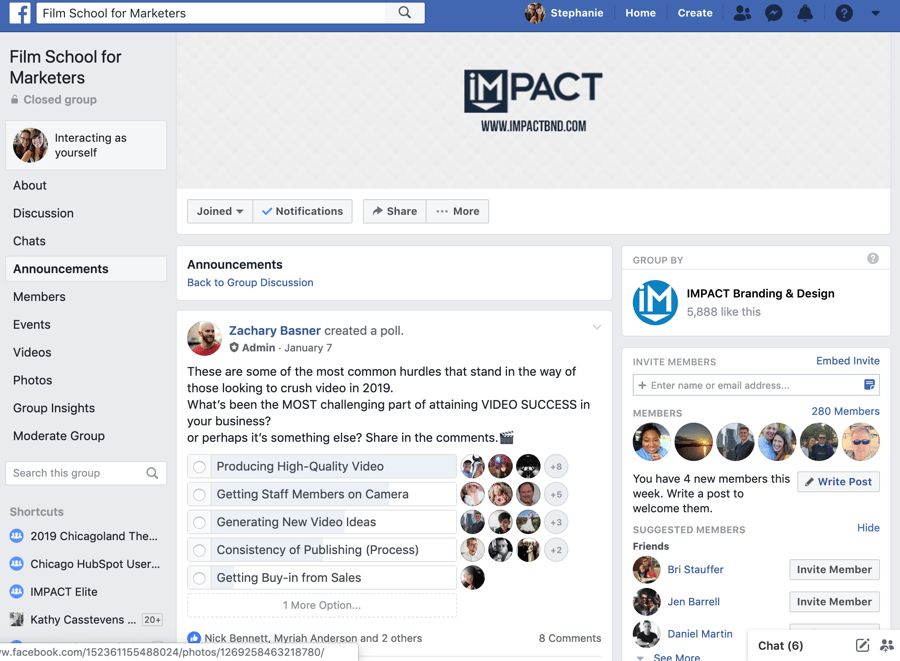
Chapter 3
Now that you know what an online community is (and isn't) and the benefits of creating one, it's time to dive in. In case you aren't sure if you're ready for a community here are some indicators that it might be a good next step:
If at least one of these applies to you then it's time to get your community on!
Creating an online community involves identifying who your community will serve, creating a purpose and mission, deciding where to build it and who will manage it, and getting executive support. That's a lot to cover so, let's not waste any time.
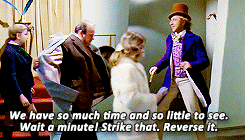
You start with your "who" because, as Monina Wagner of Content Marketing Institute explains:

“You can’t start building a community until you know who you want to serve. Before you try to figure out what sites you should be on or how to get people to participate, you need to understand the needs of your target audience.”
After all, how can you help someone on their journey if you don't know where they're going?
Defining who the ideal members of your community are will help you decide what the focus of your community should be. It will also guide you in deciding where to build your community, how to target your promotional efforts and who to invite to your soft launch.
Create a shortlist of people who you think would be interested and let them know them what you're planning to do. Ask them what they want and need and use this information to build the foundation of your community.
In most cases, your community is not about you. Even if your community were to only include your clients, it's about helping them get answers, not about selling your stuff. Ideally though, your community should include everyone - not just your customers.
Take the Sprout Social Agency Network group.
In a discussion with Sprout Social Customer Community Strategist Joe Huber shared:

"We have a Slack group that's closed to agencies within what's called the 'Agency Partner Program' (APP) at Sprout, but one thing we wanted to do was also open up the idea to agencies that weren't in the APP."
The Sprout Social team could have easily kept this as a group where agency partners ask questions about the partnership. Instead, they've opted to make it a valuable resource for all agencies with educational content and helpful discussions.
Alright, back to creating a mission for your community.
Your community's mission helps guide every decision you make going forward. Whenever you're working on something for your community you'll want to ask yourself:
Once you decide who your community is for and what value you'll provide them, write this down. This will be your guiding light but will also help you in creating content that promotes your community.
As an example, IMPACT's community is for "ambitious inbound professionals who are driven to grow themselves and their business," and our mission is to "help members connect, get questions answered, discuss trends, and become better business leaders."
One of my favorite examples of a clear community mission is the secret Starbucks Facebook group, Leaf Rakers Society. In the group's about section, it says:
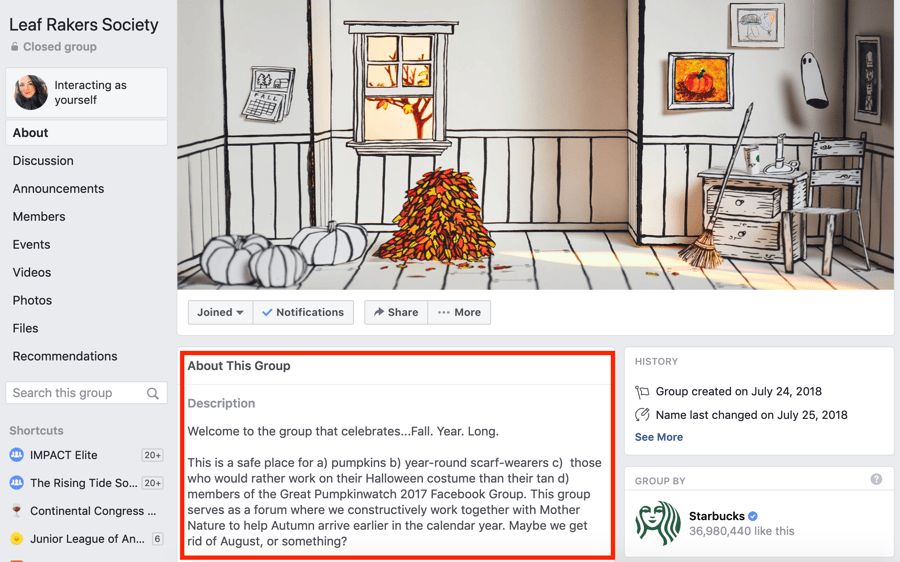
Leaf Rakers taps into something that makes Starbucks customers happy but isn't necessarily just about the drinks. There are some really die-hard pumpkin spice latte lovers but their passion doesn't end when their cup is empty. Leaf Rakers love all things fall and they love to share in that love.
"Honestly, we spent zero dollars on this," Kyndra Russell, VP of loyalty and partnership marketing at Starbucks, said during a panel. Starbucks wanted a way to celebrate their die-hard brand enthusiasts and bring them together in a safe space.
This mission guides everything Starbucks does with the group.
It guided their promotion, which was subtle and designed to catch the eyes of just the right members:
It's never too early to celebrate fall. Right?
— Starbucks Coffee (@Starbucks) August 3, 2018
If yes, go here: https://t.co/U7eSoNQcjr 🍂🎃🎉 pic.twitter.com/ORGsFtBjiD
Some other great groups I've drawn inspiration from are The Good Life group by Hungryroot and Aaptiv's official member group. In talking with Meredith Clark who manages the Hungryroot group, I asked why they created their group and what the mission was.
She said:

"We started the group in August 2017 when we were changing facilities and restructuring our supply chain. We weren't shipping during the restructure, but wanted to keep our awesome group of Hungryroot fans in the loop with the changes we were making and all of the new products we were adding."
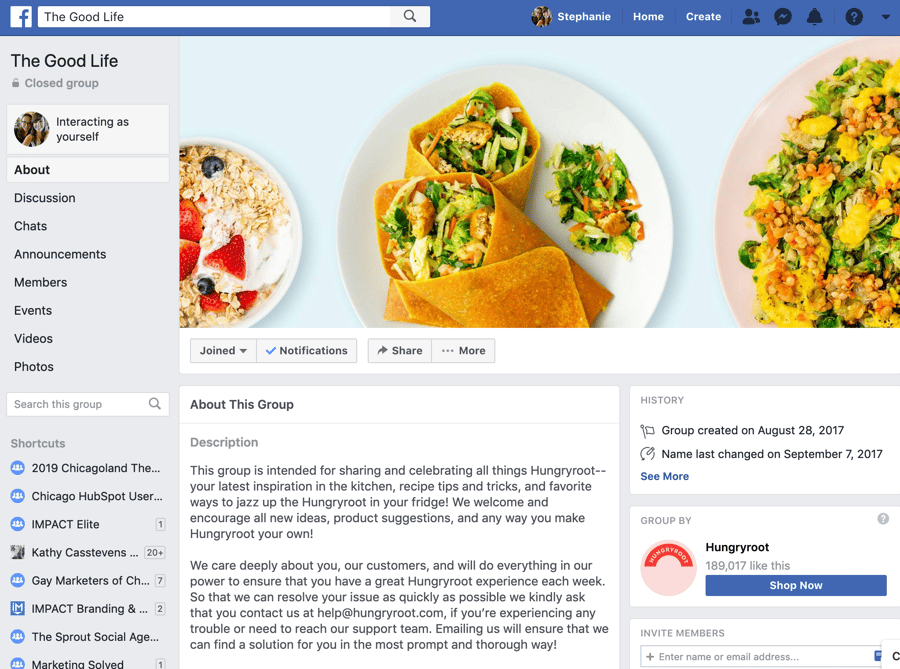
The Good Life group from Hungryroot
Clearly, your mission can change as your group grows. However, it's important to remember to keep your members and their needs at the forefront of your decision-making.
In Michael Silverman's book Capturing Community, Acquia, Inc. Founder and VP Jay Batson says:

"Communities might arise spontaneously, or be intentionally organized. Either way, they're populated by people who care enough about others in the community that they'll spend their time voluntarily to participate in it, shape it, share it, and help it accomplish something."
When I asked Maya at Aaptiv what inspired them to create their group she said:

"Our amazing members started our page! It started to grow and grow and grow and we actually asked if we could take it over in order to offer fun programming, get trainers more involved, and answer all of their questions!"
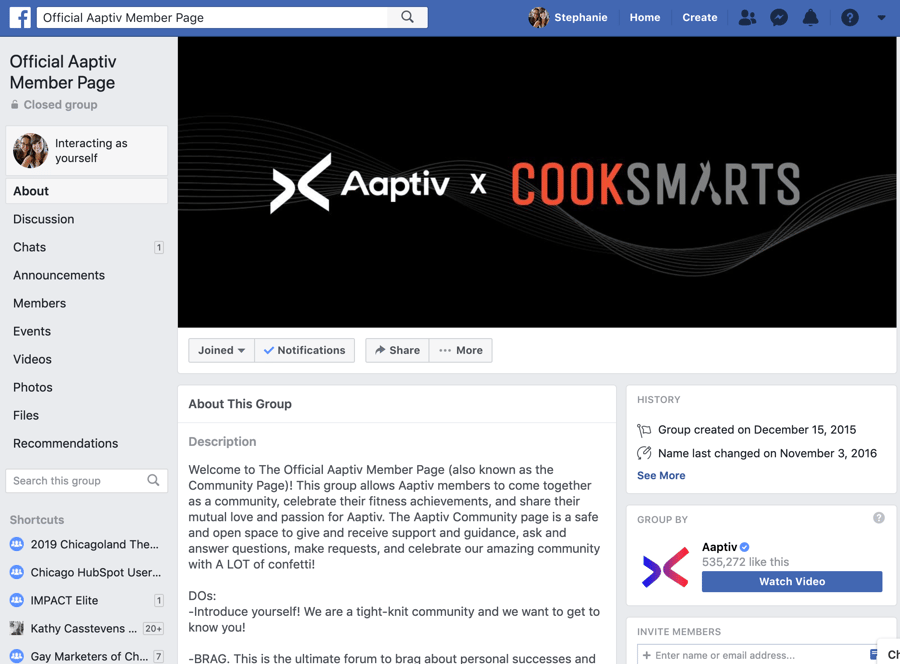
Aaptiv's Facebook group for members
If your audience has already formed some type of a community then you're already a step ahead. You may want to take the advice of Aaptiv and see if you can offer to run the community that's been created.
If you do this, be sure to explain how you intend to add more value to the community and let members know you will not turn it into a sales tool. Otherwise, prepare to lose most of your membership.
If you do take over the community, ease in. (The less you can do to disrupt an already vibrant community the better.)
If it eventually makes sense to transition the community to a different platform or change the rules, that's certainly something you can do once you get a feel for how the community functions.
While a community can exist across multiple locations, both online and offline, an online community needs to have a single, primary home.
There are a variety of options for where you can build your community. Slack and Facebook communities are definitely popular right now, but LinkedIn has the potential to make a massive comeback.
While creating your community on a social network such as Facebook or LinkedIn is certainly simpler (and free) you are putting all your eggs in the basket of the company that owns that social network.
If the idea of having your community live somewhere where you don't own it doesn't appeal to you, you can always look into an owned platform such as a community forum built on a proprietary platform or an open source CMS.
Building your community on an open source CMS -- such as Drupal -- gives you a lot more flexibility AND you own it, but it requires more resources to build.
You could also opt to use a platform built for communities like:
With so many options to choose from, what's a community builder to do?
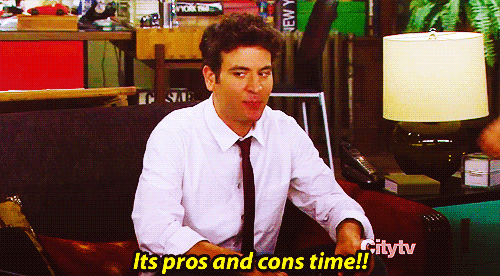
What's Happening?
About a billion people use Facebook groups every month. Building your community on a social network is great because you're creating something that lives in a place where people already go. It's not that much of an ask to get someone into your group on Facebook if they're already on Facebook every day.
For a long time, Facebook Groups were one of the few ways to directly send users a notification for group activity. Facebook continues to add new features to Groups such as the “watch party” ability, Stories for groups, and more.
Facebook has said their recent algorithm updates will highlight "meaningful interactions from family and friends over Pages."
The most important phrase here is "meaningful interactions." Facebook wants to prioritize engaging conversations and one of the best places to create engaging conversations is in groups.
Conversations from groups of which someone is a member will show up in the newsfeed. When you bring like-minded people together to discuss a topic of common interest it lends itself to exactly the kind of engagement Facebook wants to show more of in newsfeeds.
Facebook groups can be run by -- and now joined by -- Pages which allows brands to respond as the brand instead of requiring individuals to respond.
Plus, it's free. For a smaller organization just getting started with an online community, this is a huge factor to consider.
More and more people are getting away from social networks, like Facebook. We even surveyed our community after one of Facebook's data privacy breaches, to see who was getting rid of their Facebook.
When you build your community on Facebook the platform could change any time. In fact, it could actually disappear entirely.
Even though Facebook seems like it's a constant that will never falter, as recently as March of 2019, we experienced a Facebook outage of over 24 hours. In November of 2018, we saw multiple major Facebook outages within a month's time.
Those repeat Facebook outages were enough to make the most seasoned community management pros go a little but nuts:
Social Media Managers rn#FacebookDown #InstagramDown pic.twitter.com/qHi08IJ2FE
— Cannes Lions (@Cannes_Lions) November 20, 2018
If Facebook goes down you'll likely have no other way to communicate with your community. If it goes away entirely, well, you risk losing everything you've worked so hard to build.
That being said, we still built our community on Facebook.
Facebook Outage Advice
Despite engagement in LinkedIn groups falling since 2015, many people cling to LinkedIn because of its inherently professional nature.
If you build your community on Facebook you can also run into the added challenge of some people not being allowed to use Facebook at work or it not being seen as a work related activity -- even if they're engaging in a work-related group.
This is why it's important to ask your community where they already like to be.
LinkedIn has been working to revamp the Groups platform and is integrating Groups content back into the main LinkedIn experience. LinkedIn also reintroduced Group activity into notifications to facilitate more discussion and conversation.
Due to the years of LinkedIn groups being a dumping ground for spam and self-promotional content, there's quite a stigma to overcome. Despite the best efforts of group admins, LinkedIn has historically been a place where very few online communities thrived.
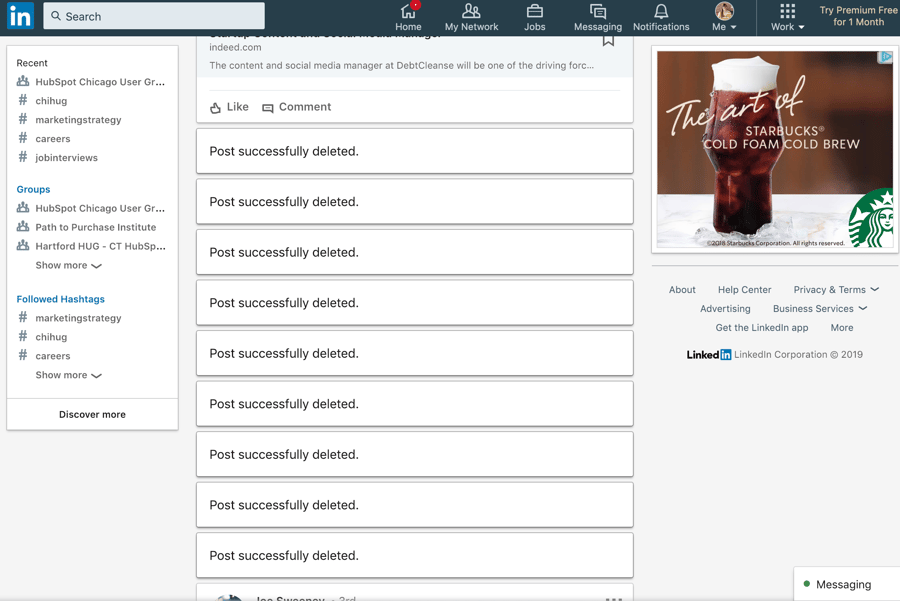
In its updates to the Groups platform, LinkedIn removed the moderator role leaving only owners and managers. They felt the roles were confusing and wanted to simplify things. This change leaves a little less flexibility for those with groups run by multiple people.
If you don’t already know, Slack is not actually about “slacking off” at work. In fact, Slack is actually an acronym for “Searchable Log of All Communication and Knowledge.”
According to Business Insider, in May of 2018 Slack had 8 million active daily users and more than 500,000 organizations were using Slack.
While it is still much smaller than Facebook and LinkedIn in terms of users and existing communities, this can be a great advantage to your business. Many people who are avid Slack users are actively looking for communities that align with their industry and interests.
Slack has a pretty robust built-in onboarding process that encourages users to take a tutorial of the platform, as well as add information to their profile such as a name, title, and photo.
Notifications are very obvious in Slack. While there are plenty of ways to customize notifications in Slack, the default is to notify users of pretty much everything. This can be a pro for your community at first but can get on users' nerves pretty quickly.
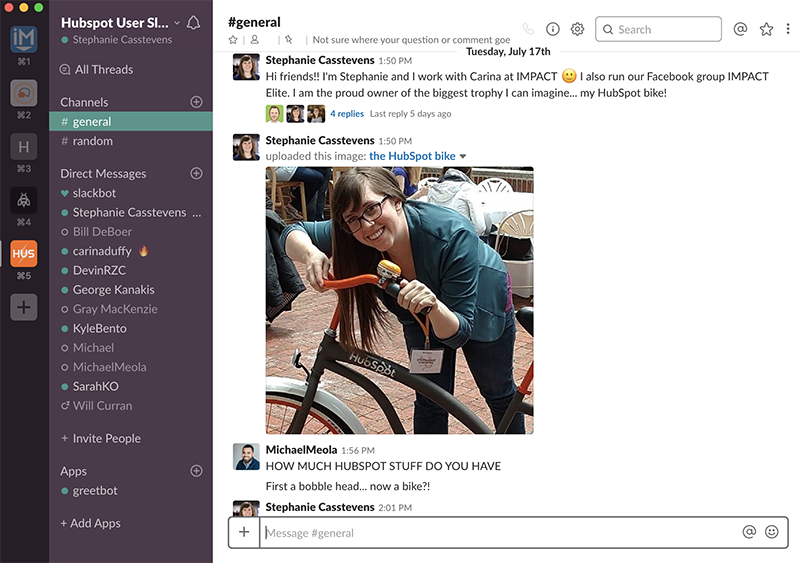
In fact, IMPACT’s Carina Duffy, cohost of the IMPACT's the Hubcast, recently worked with DigitalMarketer to launch a HubSpot user Slack -- they noticed there was no Slack community just for users, so they created one.

"We wanted to create a place for HubSpotters to ask questions, stay up to date, and build community together. There are channels for each Hub (marketing, sales, and service), plus additional channels for things like troubleshooting, HubSpot updates, hacks and more."
Depending on your industry, it's less likely that your members will already be on Slack or be familiar with it. It can be challenging to get users into a platform they're not already using. Plus, to really leverage Slack well it requires downloading an additional app and not just going to a specific social network or website -- though there is a browser version.
In addition to using a new platform, users are required to create a new profile each time they join a new Slack team. This means a new username, bio, and profile photo.
Plus, things can get a little bit confusing since users have the ability to create usernames beyond their actual name. I am in a number of Slack communities where I'm in deep, professional discussions with kittykatluvr20 -- don't ask me why, I don't know.
Finally, as I mentioned in the pros section, notifications can be... a bit much:
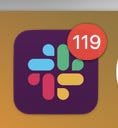
This is a very real problem.
In a thriving Slack community, the notifications can feel constant and overwhelming. Even with some customization, there can be this inherent need to keep up with every discussion in every channel which can cause very quick member burnout. And if you turn off the notifications, it can still feel impossible to catch up and it's not exactly easy to skim everything happening in a Slack community.
In addition to knowing where your audience would engage in a community, you need to look at the limits of your potential choices, as well.
LinkedIn, Facebook, and Slack all have some limits on their groups' functionality.
On LinkedIn, you can own or manage 30 groups at a time and be a member of up to 100 groups. Meanwhile, you can join up to 6,000 Facebook groups.
LinkedIn group membership is limited to 20,000. While there’s no official listed limit for the number of members a Facebook group can have -- though, after you cross the threshold of 5,000 members, admins lose some management features and abilities.
Similarly, Slack doesn't say much about the number of users allowed in a free community. There are communities out there with over 10,000 members, however, many users have found the app begins to struggle at around 5,000 members.
On the free version of Slack, only the most recent 10,000 messages are viewable and searchable. Slack teams have a 5GB file storage limit and are limited to 10 third-party apps.
Should you choose to create your community on a social network there are a few things you can do to bridge the gap between the “rented space” in the social media world and the space owned by your organization?
Encourage those who like or follow your business to subscribe to email updates, as well. You can ask for their email as part of the joining process, though this is fairly manual and can get you into a tricky spot when it comes to GDPR:
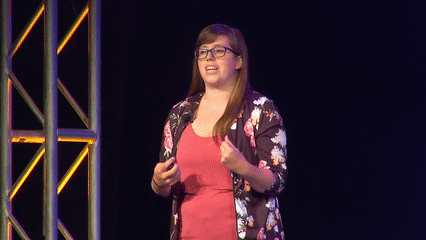
Watch my talk on How Privacy, Consent, & GDPR Will Influence the Future of Marketing at IMPACT Live '18.
Here is an example of how different groups get creative in asking for email addresses:
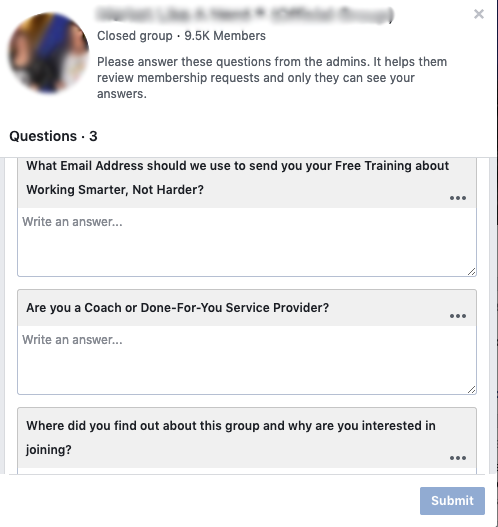
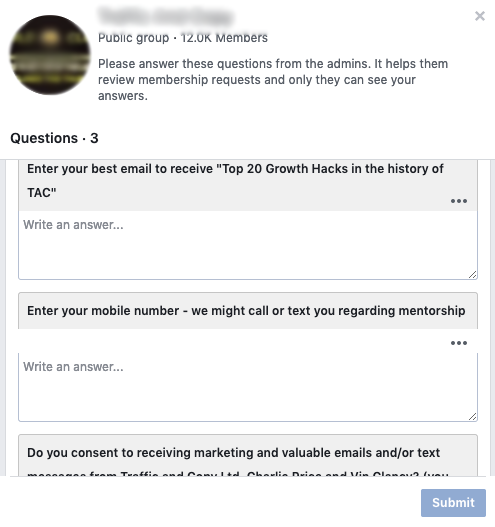
You can leverage your community to generate leads and retarget existing customers by nurturing them through email content alongside your community.
For IMPACT Elite, I write a digest email every two weeks rounding up the best posts from the past 14 days and highlighting them in a short video and email with links to more information:
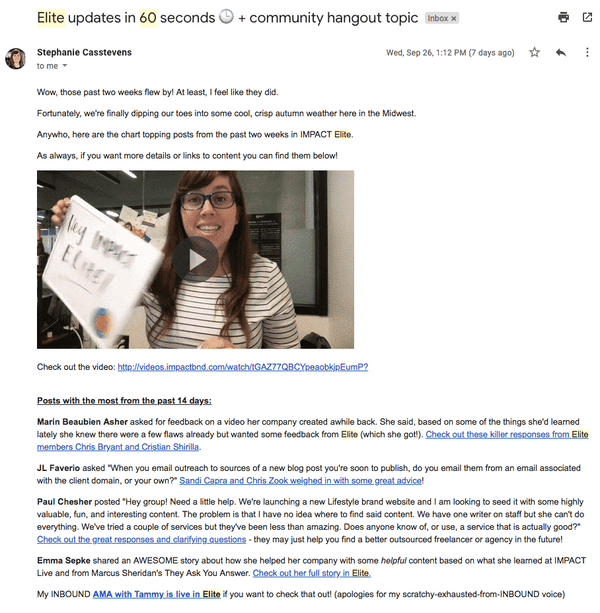
Facebook notifications can get overwhelming -- and it’s easy to miss something -- so, this gives us a way to get our members to opt into our email list while also providing them with value in return.
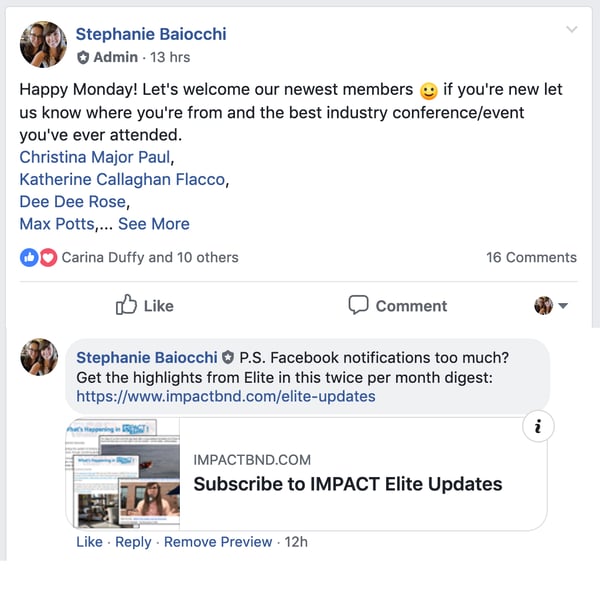
From online events like webinars and AMAs to in-person events like meetups and conferences, you can create ways for members to sign up for things outside of your community via a form on your website. This allows you to safely capture their information and consent to communicate with them.
By giving your community members exciting and valuable reasons to opt into hearing from your business outside of social media, you’ll start to bridge the gap between the rented and owned spaces. Plus, once you’ve built the tools to grow your audience outside of social media, you won’t have to panic during the next great Facebook outage.
Want to Connect?
When you build a community on an owned platform you will have fewer variables that can cause your community to disappear. Sure, anything digital is vulnerable to some risks, but you're limiting your risks by not completely relying on another business.
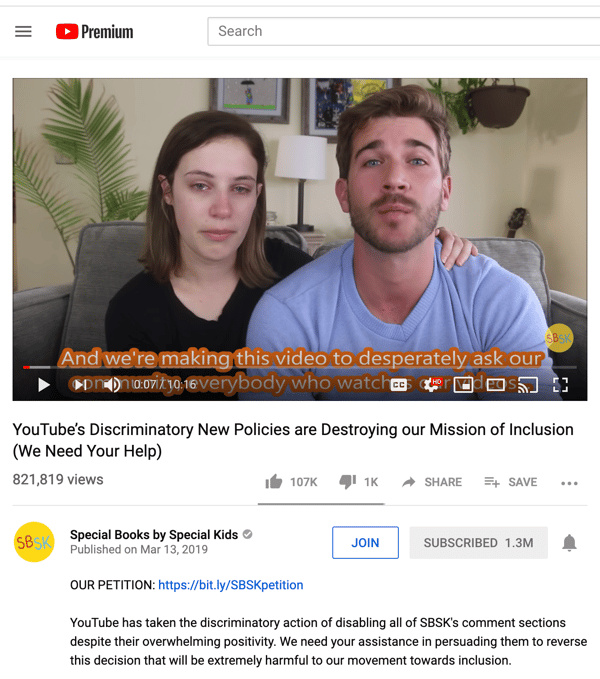
Special Books by Special Kids is currently facing unexpected issues with YouTube.
When you build your community outside of a social network, you don't have to compete with the noise and distractions of social networks. You also have better data privacy management and more flexibility with how you set up the community.
A community forum offers the benefits of a social media platform with a lot more flexibility and granular control. Granted, it may not be where people are already going but, the fact is more and more people are getting away from untrustworthy social networks.
Some of the more detailed options you have when you build your community on an open-source platform, such as Drupal, include granular permissions, integrations with other data sources, plenty of room to grow and scale, and single sign-on (SSO). These features allow you to go beyond the limitations of social networks while also creating a more secure, private space for your members to interact.
Plus, communities built on dedicated platforms have improved accessibility

"Web accessibility considerations take into account users with visual impairment, color blindness, difficulty controlling a mouse, auditory impairment, those who rely on a screen reader and other issues that may make the internet a more daunting place."
When you create a community forum you're asking users to go to a brand new place that they're not accustomed to.
Plus, building your own community, even using free, open-source software such as Drupal, can cost anywhere from $5,000 to $75,000, depending on your needs.
Open Social is a Drupal Distribution, which means it features Drupal Core and additional software that makes it possible to create your own community, intranet or network. You start out a few steps ahead and can customize it to your needs and goals.
An example of Open Social is the United Nations' online community at www.youth4peace.info. It was built to “provide users and partners access to relevant and timely information and knowledge on youth, peace, and security and act as a virtual meeting place for those striving to collaboratively support and enhance the participation of young people in peacebuilding.”
With all that information you still may not have a solid answer to where you should build your community. I recommend considering where your ideal members are already spending their time. Ask them if they're in any other communities and ask them where they might like a community to live.
Second, look at the plans for the future of your community:
Choose a platform that will work well for your members while allowing you to fulfill your community's mission.
You're Not Alone:
Chapter 4
If there's anything I've learned from managing both offline and online communities, it's that someone must own it.

ICYMI, I'm that person at IMPACT. 👋
The individual responsibilities can be divided up but there has to be one primary person who ultimately claims responsibility for the community.
It doesn't necessarily have to be someone's full-time job, especially not at the beginning. However, the person who owns managing your online community will need both time and resources to be successful. You can't possibly manage a community in the off hours.
Whether or not you need to hire a community manager depends on the goal of your group(s), the rate of growth, and how many other people at your organization are committed to investing time in the community.
According to ReferralRock, more than half of surveyed organizations rely on one or more full-time community managers to do the job.
Regardless of whether or not you hire a community manager, you need to pick someone to own this initiative. The different tasks such as moderation of posts and admission of new members can be delegated out between team members. You can even invite community members to assist in moderating the group and helping minimize the burden on the community manager.
Still, one person needs to be the go-to owner for the final word on matters of your community. It will also help your members when they know who the correct person to turn to is if they have a question or concern.
If you do decide to hire a community manager, look for someone either currently engaged in social or community activities in your organization or someone within your community who is very active.
Contrary to popular belief, you do not necessarily need an extrovert. You're just looking for someone who is willing to put their personality out there and be approachable and honest.
Community managers do wear a lot of hats and their role is often combined with other similar roles (such as social media manager) depending on the size and scale of the community. Here are some of the things a successful community manager needs to have on lock:
One of the most common reasons communities fail is because of community manager burnout. The biggest factor causing that burnout is a lack of resources and support for community managers. When communities lack resources and support, it's usually because there's no executive buy-in for that community.
An organization-wide commitment to the community is the best way to avoid community manager burnout and maintain engagement in the group. The only way to achieve this is through support from the top of the organization.
Maya shared that Aaptiv's Facebook group definitely benefits from the entire organization's buy-in:

"Everyone at HQ is constantly checking in with what's going on in the page and it motivates a lot of the work that happens here. Ethan, our CEO, is in there every day chatting with members and getting to know them. We always make sure our goals here align with what our members want and need to make Aaptiv the best possible experience."
Chapter 5
An online community needs a name and branding, just like a business does. The exact branding elements needed may depend on where you build your community and how you choose to promote it.
When it comes to naming your community you want to consider the purpose and mission of your community. I recommend choosing a name that is both easy to spell and say out loud. Leave as little room for error as possible. Be sure to check if the group name is used anywhere else and confirm it isn't used inappropriately for any reason. (Yes, this happens, and it's not fun.)
As with any content representative of your brand you need to keep your voice and tone in mind.
When it comes to design, you may want to carry over your company branding to your community or just borrow certain elements from it. There are subtle ways to do this such as using consistent colors, fonts, and themes.
For example, here is our IMPACT branding and our IMPACT Elite branding:

vs.

When it comes to the content and tone you strike, you'll want to keep your personality consistent but modify your conversation style to match the channel on which you’re engaging. Don’t be afraid to have fun with it but keep your brand guidelines in mind.
One of the most crucial elements of your online community is the welcome content. It sets the stage for how people will engage in your community, reminds them of the rules, and encourages them to jump in right away.
In your welcome content you'll want to have a very clear description of the purpose of your community along with the rules for members:
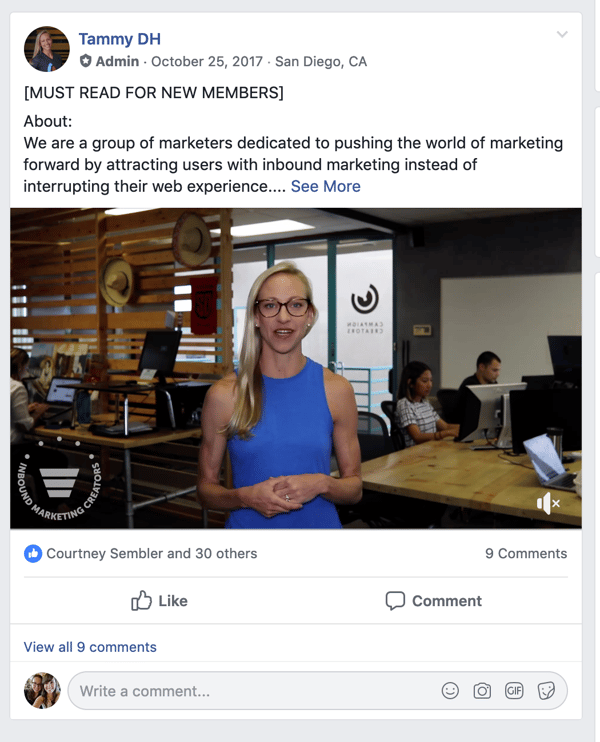
On Facebook and LinkedIn, this is usually done with a "pinned" post that sticks to the top of the content feed. In Slack, this is probably a welcome channel. If you're building your own community you can decide exactly how the welcome content will function:
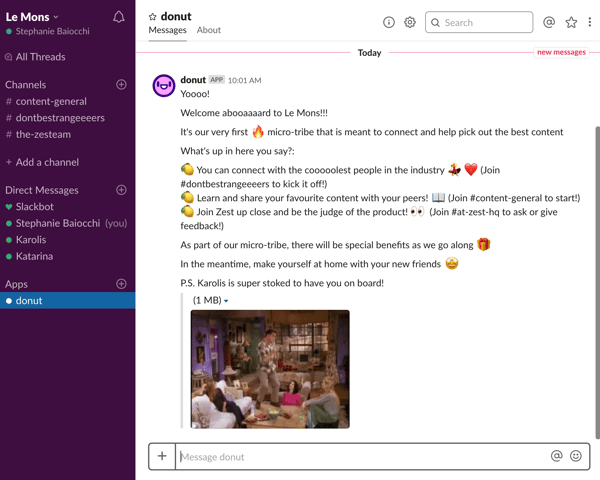
It's important to create clear rules for your group. Even if you know your group members will be good about behaving in the group, it helps to have rules in place so you can reference them in the future to keep everyone interacting positively.
This is a great example of group rules from Word Workers:
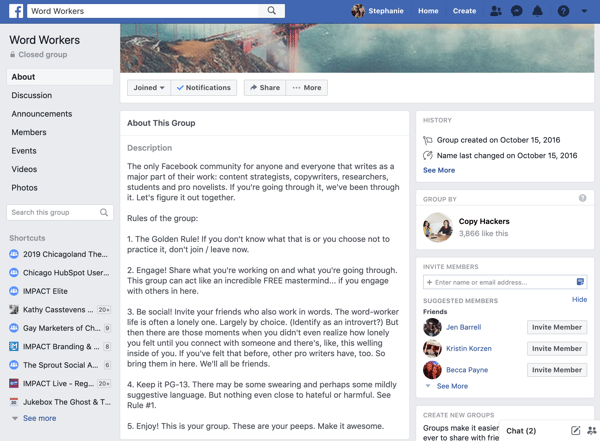
Some platforms have a dedicated space for community rules to live. If not, you'll want to pin your rules or create a way for each new member to be introduced to the rules as they join. The folks at Beyond Blue created a great page with an intro video and clear rules for their community.
Including an intro video where you welcome members to your group can also be a great way to set the tone right away when someone joins. When you use video to communicate a message you start building trust with your community immediately, because you're willing to put your face and voice behind your message.
Too often, we are sucked into the trap of typing out a message that we wouldn't actually say to someone's face -- just because it's easier. Starting with video also helps you better convey tone, as well as the inflection in your voice that you couldn't necessarily convey in writing.
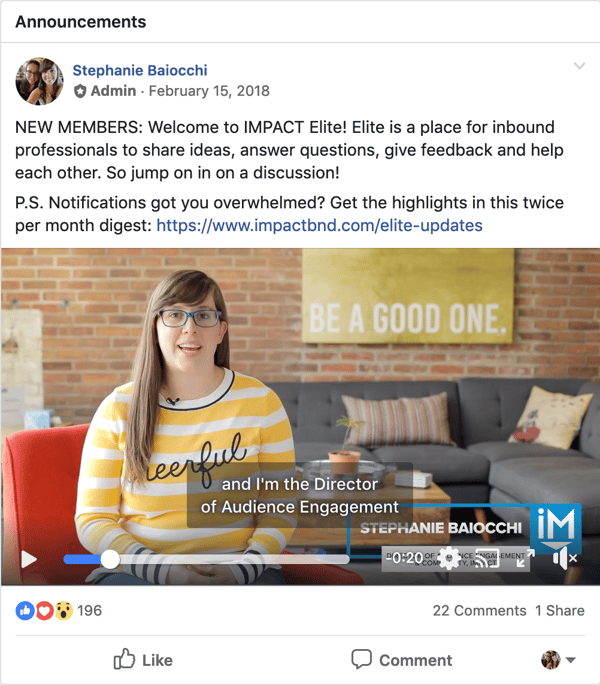
If you do include video it's absolutely vital that you include captions, as shown above.
This is not just for deaf or hard of hearing members but also for anyone watching the video in a situation where they can't have the volume on. Personally, I know I've watched anywhere from five to 20-minute videos on mute.
Yes, you do miss out on the tone and function in this case, but you still got the facial expressions of the speaker and the authenticity of the fact that they were willing to stand behind what they said.
Chapter 6
When it comes to actually adding members to your group, there are a few things you can do to make sure you get the right people in the right place.
You don't have to launch an absolutely beautiful and perfect community, publicly, right off the bat. In fact, it's probably in your best interest to not do that. Imagine if you joined a group that had been totally hyped up only to find out there were only two discussions in it and maybe nine members. This would be quite the letdown.
Instead, focus on leveraging your list of super-engaged clients and employees to start small. Remember that list of people you reached out to earlier?
Tell them about what you're working on and why you're doing it. Invite them into the community early on and encourage them to start discussions and give you feedback. Once you have a few people in the group and the discussions get started, add in a few more.
Eventually, your group will start to grow naturally and with the push of a little promotion, you'll be on your way while standing strong on a firm foundation.
Asking the right questions of potential members is a big part of a successful online community.
Facebook groups have a built-in feature that allows you to ask up to three questions of people who request to join your group. For other communities, you may have to build this on an external invite page.
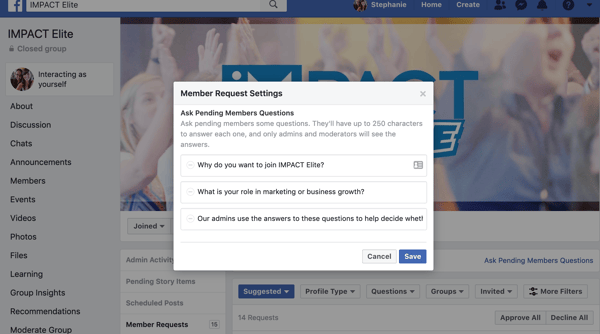
When I took over our Facebook group, IMPACT Elite, I kept track of the answers of the first 500 members I accepted into the group. I pasted them into a spreadsheet every time I approved or denied a request. I analyzed the answers to these questions to help decide where to go to grow our group.
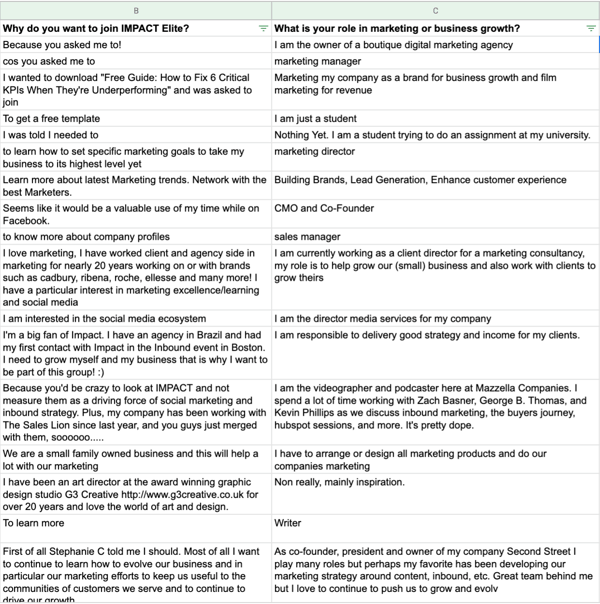
In one year, I approved 2,800 new members of IMPACT Elite and declined 1,400 potential members. This means I approve about two-thirds of requests and decline about one-third.
This is not a standard I try to keep up with in any way. In fact, I didn’t know this was the breakdown until looking this up to add it to this section! It's certainly a good reminder that sometimes you have to turn people away, even if it means your group grows more slowly.
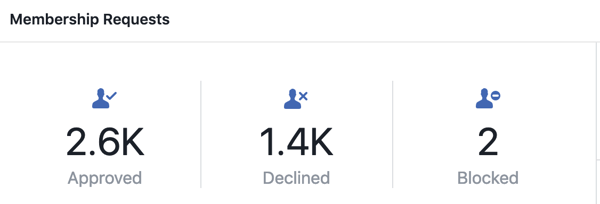
Of course, we consistently get join requests from people who don't answer the questions. At first, this happened quite often. At the time, I would review everything about twice a week and find people on LinkedIn to get more information before deciding whether or not to add them.
Now, there’s no way I could keep up with that at the rate we get requests to join.
So, I decided to add a third question, letting people know that I would be reading their answers. I changed the last question from:
"Are you ready to be Elite?" to...
"Our admins use the answers to these questions to help decide whether or not to approve requests to join. Are you ready to be Elite?"
Sure enough, not only did we start getting more people answering the questions, we started getting better answers, as well.
If your community does not live on Facebook, you can implement this on your own by requiring people to submit a form on your site with a few questions before joining. (Psst! This also means you get their email opt-in!)
Some groups even go so far as to state this information in their "about" section. The marketing Facebook group BAMF (Badass Marketers & Founders) tells prospective members if they're a member of more than 30 Facebook groups they're not getting in -- no matter what.
I find this really interesting since in this thread in Elite there are many people who belong to more than 30 Facebook groups. Plus, I'm even a member of more than 30 groups. Wedding planning and resale groups, personal health and fitness groups, etc.
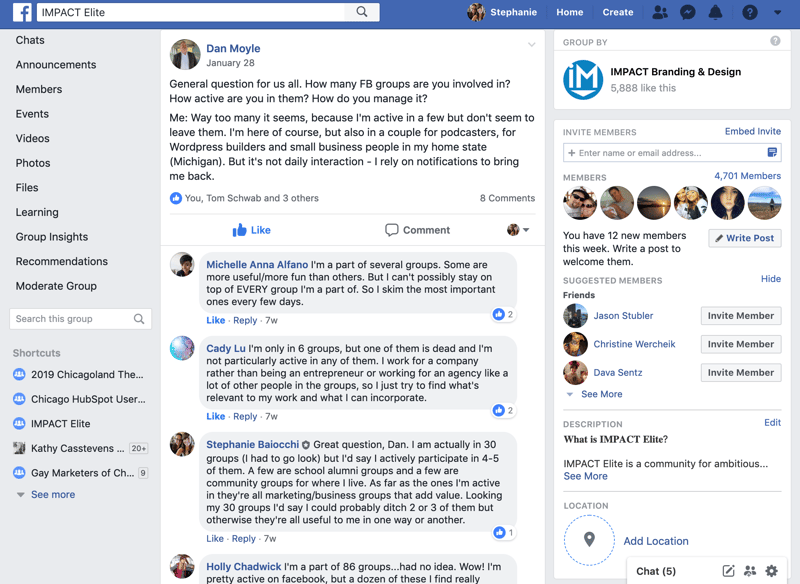
Chapter 7
OK, so you have an online community with a name, some branding, and a few members. Now what?
See if there are any other groups in your industry -- and join them!
Not only can you draw inspiration from groups that are similar to yours, they will also likely not be competition. People can be in more than one group and it will not cost them anything except maybe some time or some of their attention.
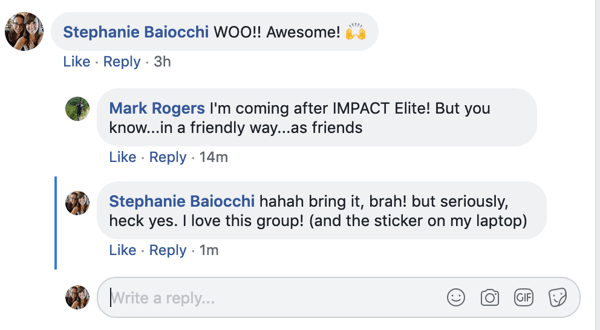
I am friends with admins of at least three groups that share many members with ours.
Plus, if you are a member of groups purely based on your interest that aren’t related to your organization’s industry, you can still draw inspiration and ideas from these communities.
To help you understand what goes into managing a community -- because yes, it can very easily become a full-time job, as we've already discussed -- I want to take you behind the scenes of what I do every day.
So, what does a typical day in the life of Stephanie look like?
Well, I start every day by checking on our community. OK, actually, I start every day by brushing my teeth. Then, I make a cup of coffee and pull up IMPACT Elite on my phone.
Many people will caution you against this, but it helps me approach my day head on if I get an overview of what I missed while I was sleeping. We have many members of our community in different time zones who post to the group when it's nighttime for me.
Then, I head into my office. I have my daily meeting with my team where we go over what's going on that day and then I settle into my to-do list.
I probably check on our community 50 times throughout the day without even realizing it. Maybe one of these days I will try to count it. However, the thing you may find surprising is that I do not get Facebook notifications on my phone. That's right, I will not see a Facebook notification unless I open the app. This is a vital part of my ability to focus on my work and not be constantly distracted by every little thing.
You have to set boundaries for when and how you'll be available.
It's incredibly easy to get sucked into being "available everywhere all the time." I've been there and I can tell you it's neither productive nor sustainable.
In fact, you'll wind up looking like this:
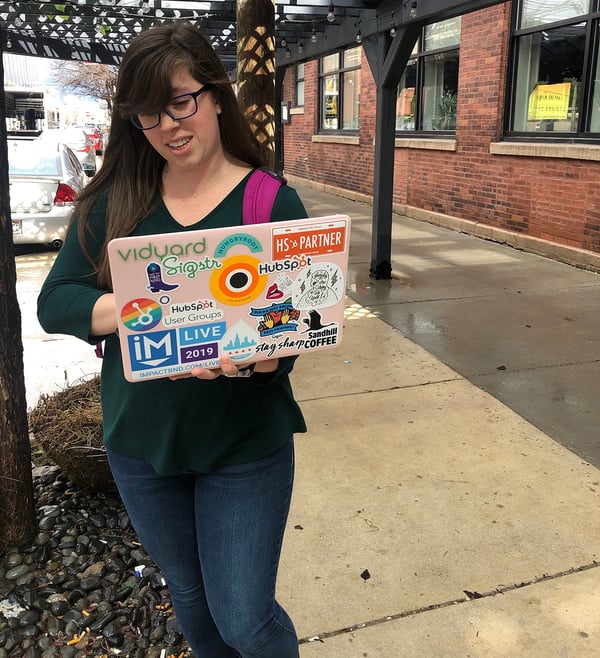
I do have dedicated time on my calendar set aside to engage a little more deeply in the community. Make sure you maintain the conversations that have been started. Say thank you to those who take time to contribute or ask questions. When people take time out of their day to engage in your community that is a big deal.
Don't take it lightly or you'll lose it before you know it.

"I spend time every day going in and making sure every question is answered or responded to. When I see something where I have no business answering the person's question, I'll still comment on it to bring the conversation back into view. It's really just about making time to respond and post to keep people engaged."
Plus, by keeping conversations alive, many social networks will prioritize them in news feeds.
Of course, there is no perfect answer to the question of, "How often should I post in the community?"
That said, consistency does yield results. You don’t have to post every day but if you post often and then suddenly disappear for a week, your members will notice. Going on vacation? Be sure to let your group know and appoint someone in your organization who can be your stand-in for the time you’re gone.
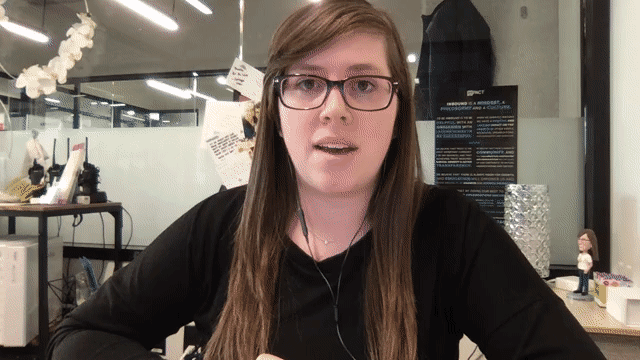
Watch this video first.☝️
So, in that video, I mentioned an article Ramona wrote about a response she got to an email. To be clear, you may not encounter responses of this severity but it's certainly possible. Remember that it's okay to talk to someone if it bothers you or you aren't sure how to handle it.
In addition to the daily responding and posting in the community, every other Wednesday I round up the most engaging discussions in the community and bundle them up into my email digest.
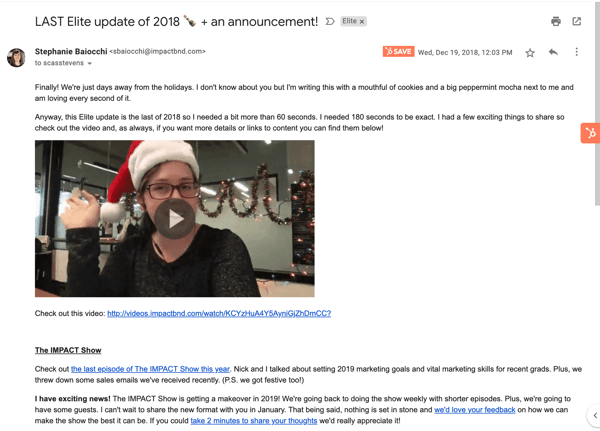
This also involves creating a quick and fun 60-second recap video for every email. Here are some of the past videos:
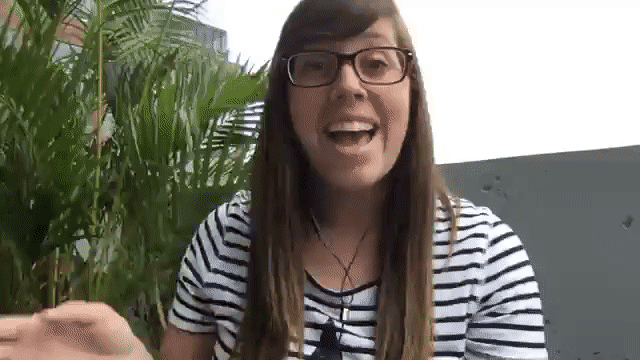
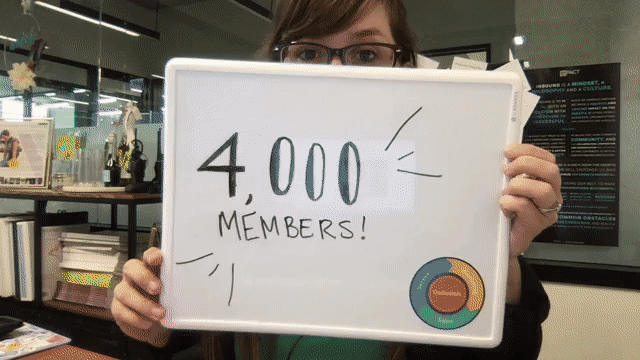
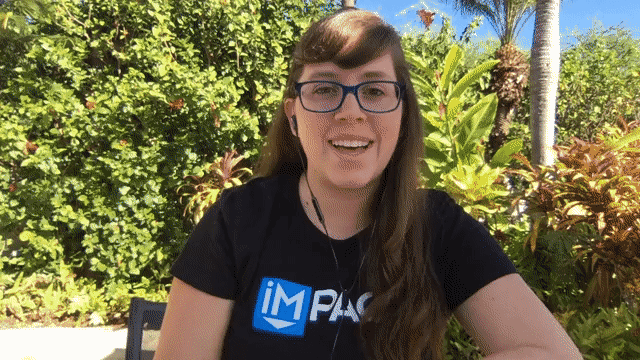
Many people ask me if they should be responding as themselves or on behalf of their organizations.
If you have a team of people responding on behalf of your brand it can help to have those people add their initials to the end of responses. This helps you keep track of who posted what in case an issue arises. It also reminds members that while a brand is replying to them, there are real people there that care.
If possible, it's often best to engage in the community as yourself. The more you can be authentic and vulnerable with your community the easier it will be to build trust and break down the walls that separate you. Your community should see you as a trusted liaison to the organization.
From time to time I will reply to something on behalf of IMPACT when I want to add a bit more credibility or importance to the comment. I do not mean I want to make IMPACT’s response sound smart. I use the brand to elevate and empower members. I might, as myself, say thanks for commenting. However, if IMPACT comes in and says “that’s a great point, we agree!” it’s going to make the original poster feel more special and valued.
You’ll want to address any content that diminishes the quality of your community. If something is truly spam or is offensive, you can hide or delete it. I often take a screenshot before doing so just in case I'll want to refer to it in the future.
If you encounter truly inappropriate content that violates the platform's community standards or terms and conditions, you'll want to report it to the platform you're using, or to your IT team, and make sure it's removed and the user is blocked.
For reference, in the past 12 months, I have only had to block three people from IMPACT Elite. Often times, simply removing the person from the group is sufficient.
This does not mean you should immediately remove sensitive comments or content that sparks a controversial discussion. This can easily be seen as censorship or as if you’re only allowing content into the group that benefits you and your brand.
If something is not spam but breaks the rules of your group or is blatantly promotional there are 3 options you can consider:
Options two and three allow you to show them that you’re invested in them getting value out of your community and will be more likely to encourage them to stay and give participating in the group another shot.
Facebook even allows you to give feedback on the post to the original poster before removing it.
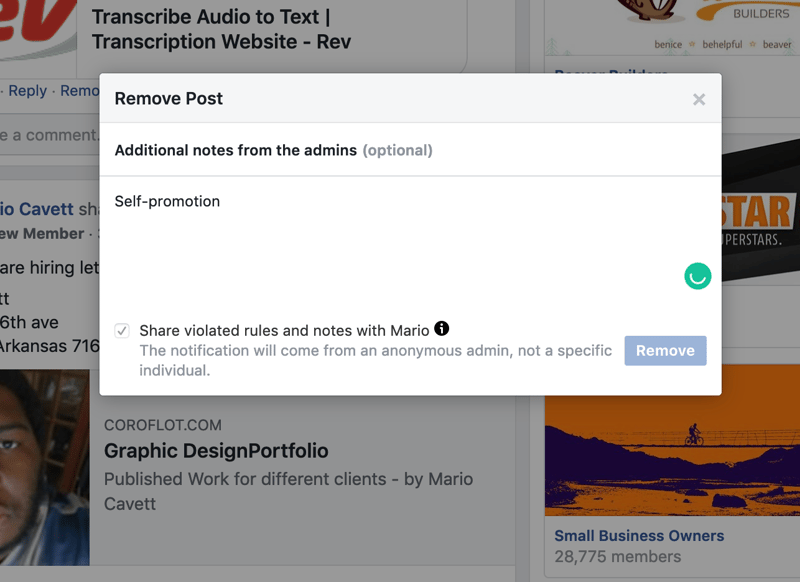
From daily administrative duties to larger growth initiatives, there's a lot that goes into managing a community.

"I always equate running a community is like being the chaperone at the sixth-grade dance. People might show up in droves, but they'll sit by the punch bowl or the bleachers, talking to their friends. It's not until the dance floor has some serious action that you'll see other people join in. We have to find ways to get people commenting and posting. Nobody wants to invest their time in a digital ghost town, so by being the first people on the dance floor ourselves, we know we'll get more people to tango with us."
I like to think of my members in a few bulk categories to help guide my engagement with them. They are newbies, lurkers, regulars, and leaders.
Newbies are the members who most recently joined the group and are still finding their footing. They may introduce themselves on a welcome thread but not jump into asking questions right away. Be sure to welcome new members to your group and give them a question to answer when introducing themselves so they have a clear reason and way to engage right away.
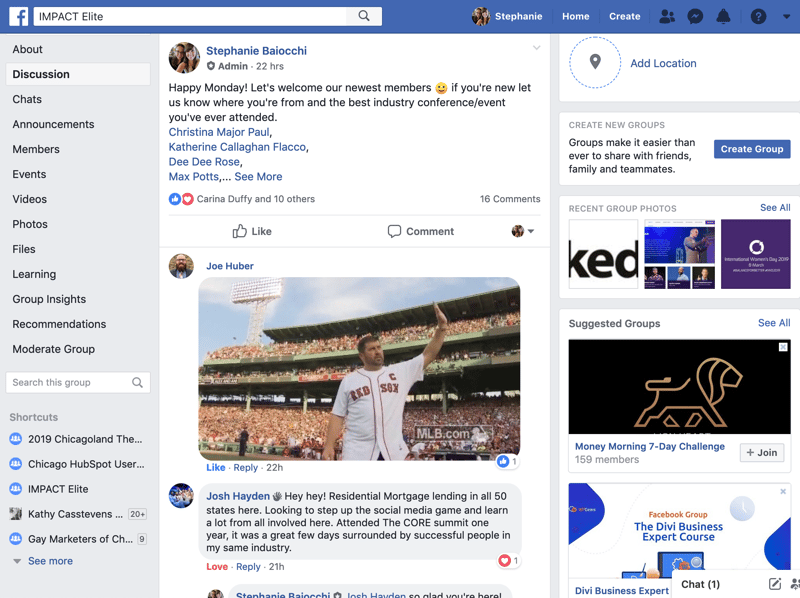
These are the people who join the community and occasionally "like" a discussion but never comment or ask a question of their own. They still may be getting massive value out of the content but it's hard to tell. Surveys and polls are great ways to engage lurkers because there's very little pressure and doesn't call attention to them individually.
Here is a great example of a poll in Personal Branding with Video:
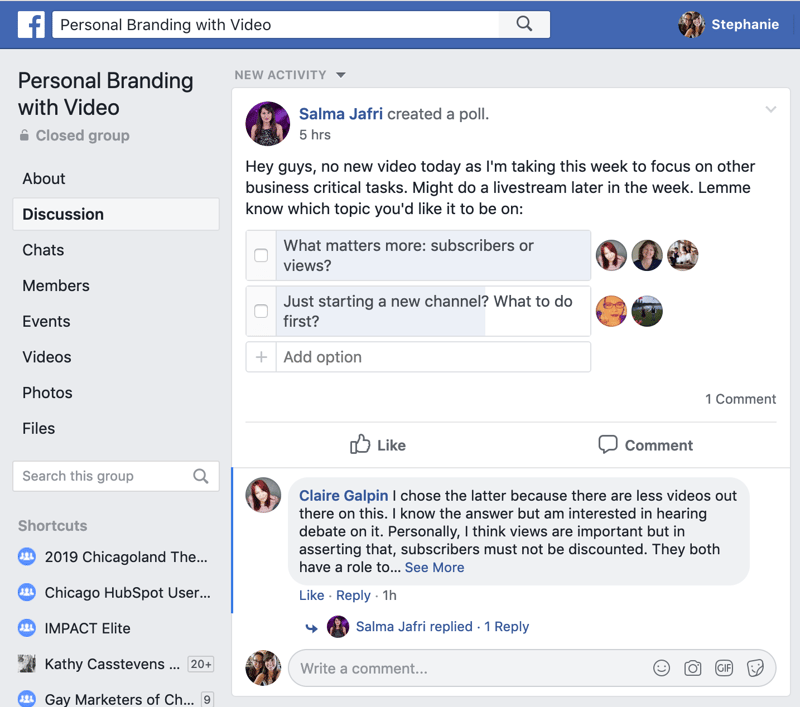
After some time your group will develop a collection of members who stop by often (a couple of times per week) to engage in discussions. The goal is for them to see your community as the go-to source for getting feedback or getting answers to their questions. They'll enjoy going to the group and will even get to know each other a bit.
The leaders in your community will clearly stand above the rest. They consistently welcome new members, answer questions, and participate in discussions. Leaders often like to be acknowledged for their contributions to the community and will appreciate a shout out or being tagged in a discussion because of their expertise. They're likely willing to help with a campaign or give you a testimonial as well.
By knowing the member types in your community you can effectively create content that will engage all your members.
Chapter 8
Some common challenges that come along with growing an online community include keeping track of repeat content and pushing announcements to your entire member base.
Keeping track of repeat content can be one of the most challenging aspects of managing a community. If your community has a built-in search feature the best thing you can do is teach your community how to use it. Beyond that, round up content and email digests are easy to search after the fact. After some time, old discussions will be outdated anyway.
Sometimes, you'll need to publish an announcement to your entire member base. Most social networks have a way to do this and pin it as an announcement or top post. However, if members have notifications turned off they may miss it. This is yet another instance where the safety net of an email opt in list comes in handy. Sensing a trend yet?

“The hard part is getting the people to join. You’ll have to give them a reason to join, stay, and engage."
A valuable and targeted community mission is a great first step. However, even the best community won't thrive without promotional effort behind it.
In this video, I explain some of my favorite ways to promote an online community:
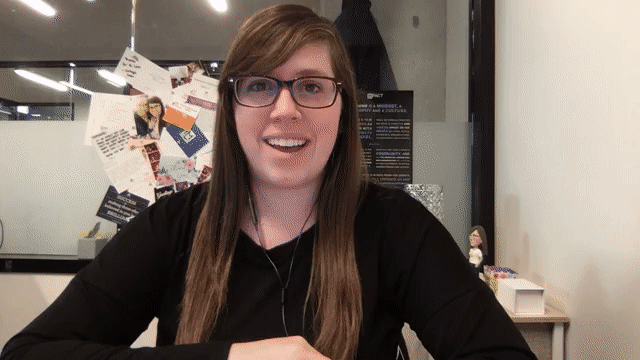
In my video I mention Sigstr. This is a tool we use to add marketing content to the email signatures of every email sent by anyone in our organization. It's a quick and easy way to get the word out at scale.
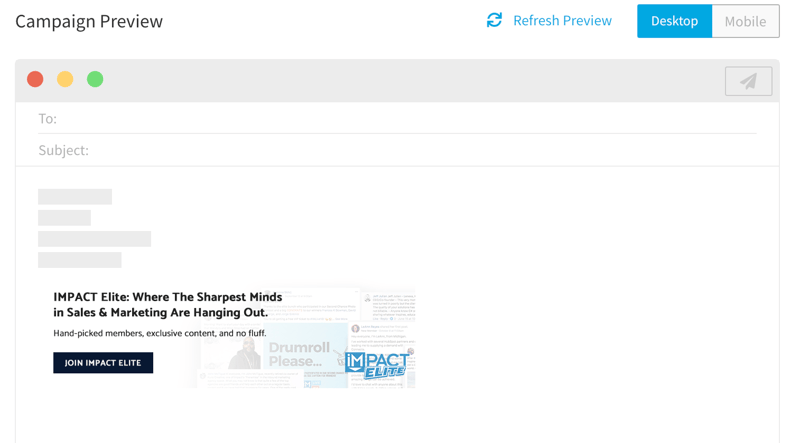
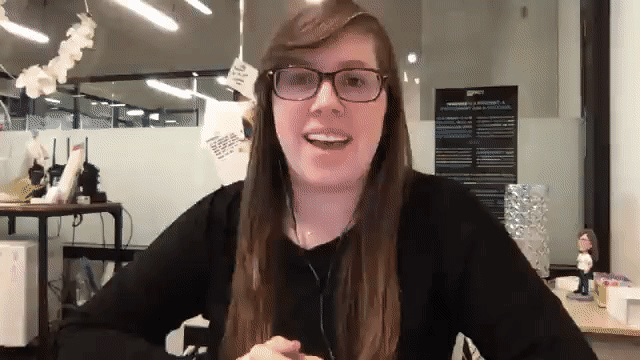
Here's what our thank you page used to look like:
.jpg?width=800&name=thank%20you%20page%20old%20(1).jpg)
You didn't have to join Elite to get the download, but the layout of the page made people think they had too. So, we started getting requests to join IMPACT Elite like this:
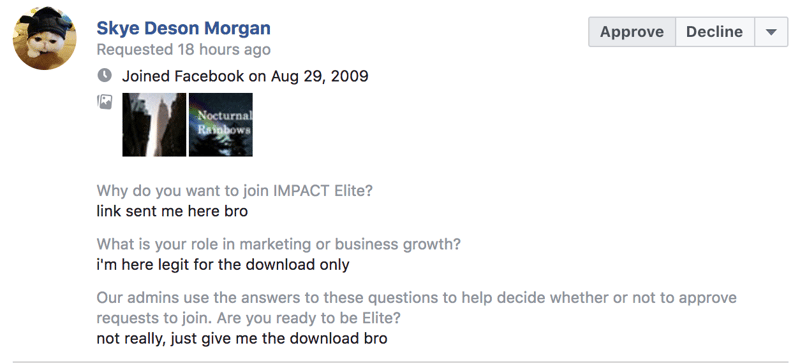
Sorry, bro. 🙈
Here is our new and improved thank you page:
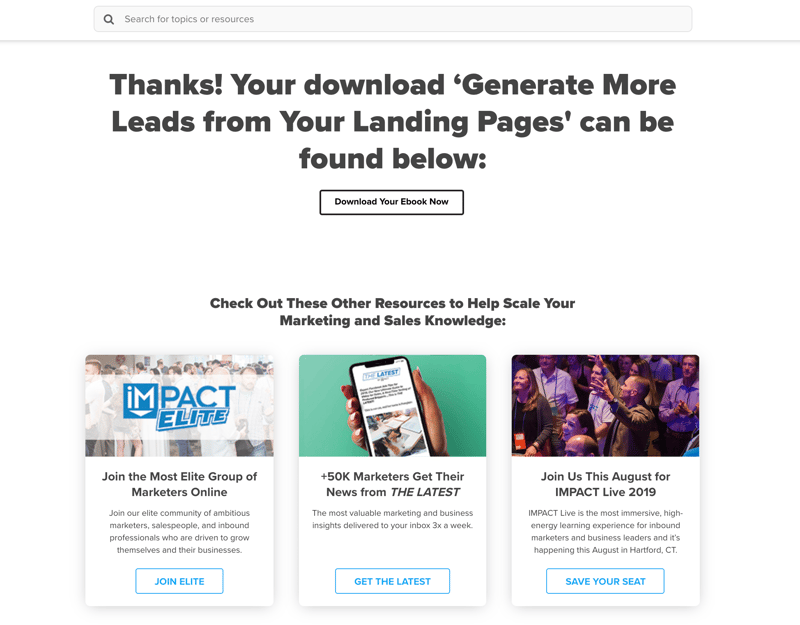
Another really fantastic way to get people into your community is if you use a chatbot or live chat on your website. People are probably here because they have a question. Of course, you'll want to answer it and help them but maybe you can direct them to your community to get more in-depth answers or ask future questions.
Here's what that looks like for IMPACT:
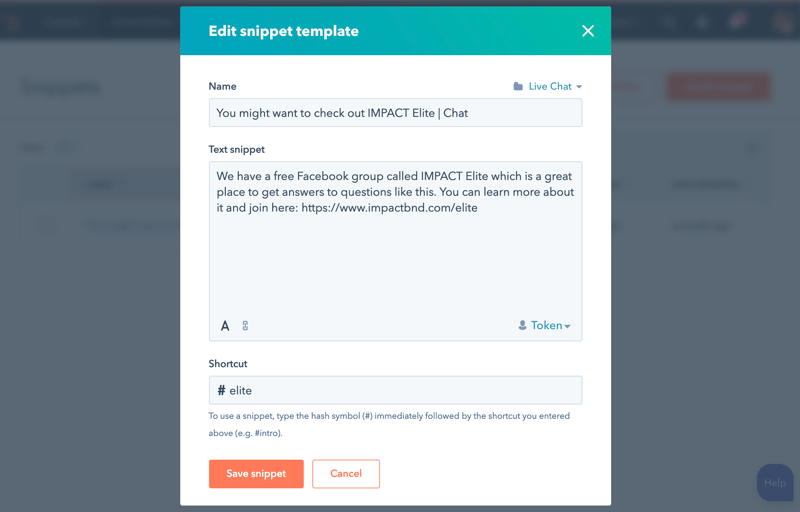
(We use HubSpot Conversations for our live chat.)
There are platforms, like ReferralRock and PartnerStack, that can help you track referrals. You can also use a simple Google form or even a simple spreadsheet.
.jpg?width=800&name=21%20elite%20referral%20from%20friend%20(1).jpg)
Encourage members to invite others who are a good fit. Then, reward them when they do so. Great communities are grown through word-of-mouth. Rewards do not have to be monetary or even physical.
Another great way to get the word out there about your community is to create content featuring community members. This encourages members to share on their own networks.
While some community content is private to your members only, you can create great collections and roundups of community member-generated content and publish it on your site. This also gives prospective members a glimpse into the kind of content discussed in the community.
We asked our members about whether or not they do work stuff on the weekends and turned it into a great piece of content. We also asked for the most cringe-worthy marketing mistakes they made, to build some camaraderie in the group, and turned that into a fun article (with their permission of course).
It's important to leverage every available opportunity to promote your community. Here are some of the can't-miss ones to make sure you have on your list:
As a community manager, it's your responsibility to advocate for the members.
If their question isn't getting answers, ask clarifying questions. When someone shares something they're clearly excited about, take a second to comment and thank them for sharing.
If someone could use the help of a subject matter expert, chances are you know the best person for the job. Tag them to jumpstart the conversation. If they don't respond be sure to reach out individually and let them know you tagged them.
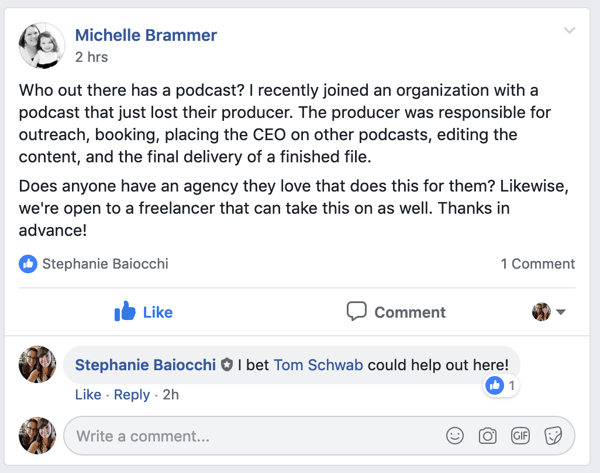
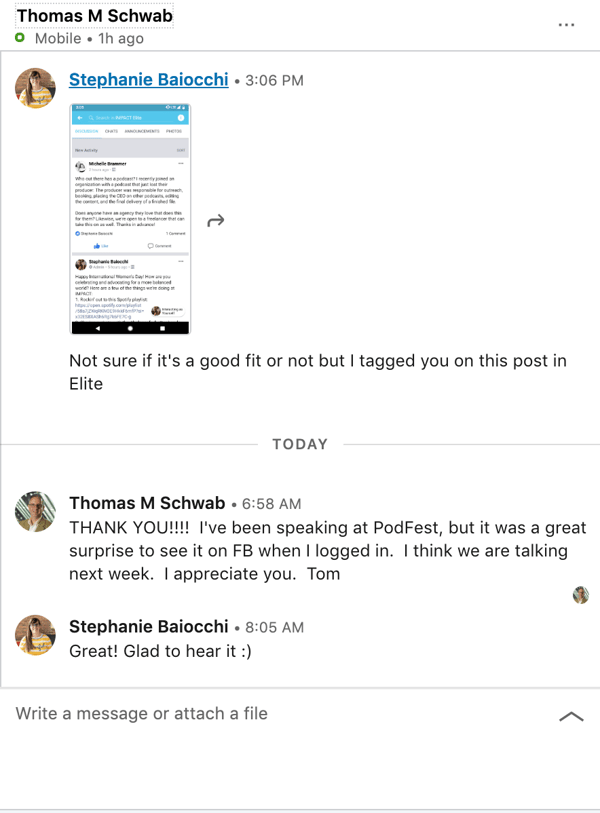
From “Monday Motivation” posts to wrapping up the week on a Friday afternoon, having traditions in your group will encourage everyone to engage often and will also give you and your members something to look forward to.
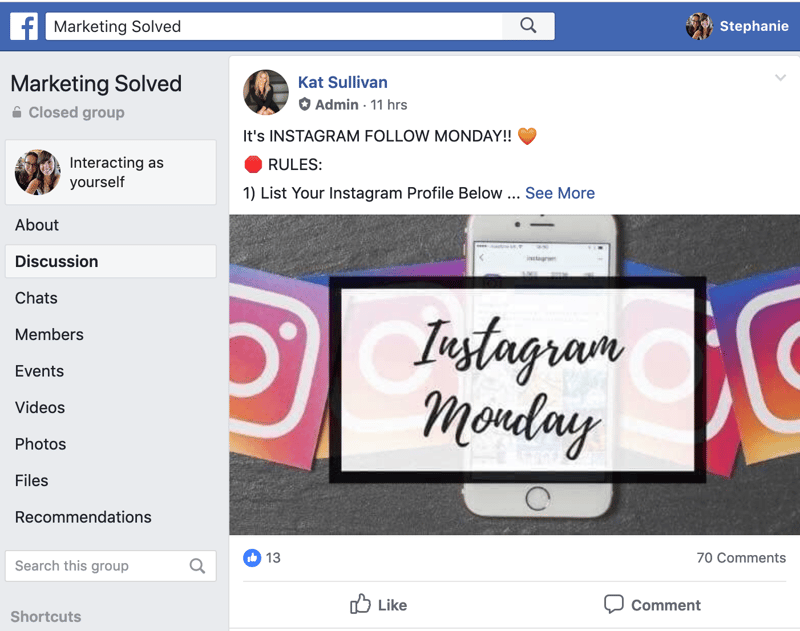
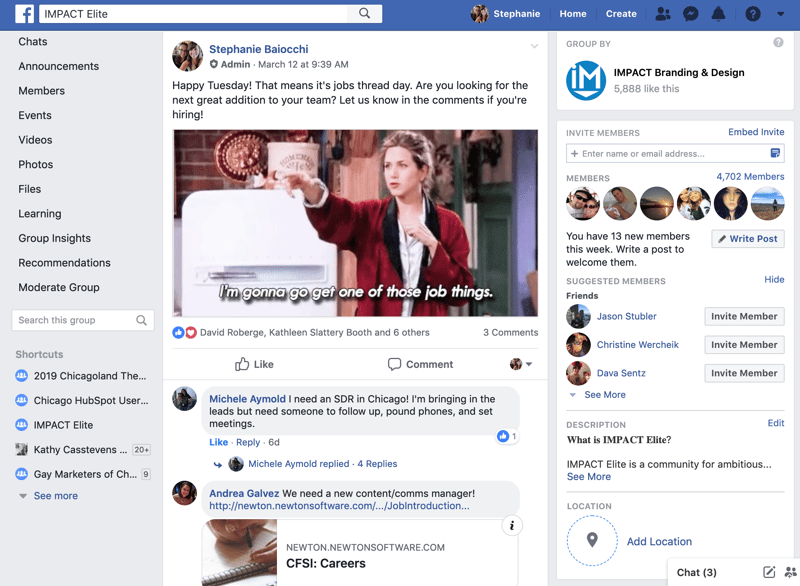
Examples of traditions in action!
Of course, not every tradition will work.
If you're going to try a new one I recommend letting your community know you'll be trying it and for how long. Say something like, "For the next six weeks, we're going to try a weekly segment..."
And if you're not sure how something is working, ask your members! Facebook, Slack, and most community software have built-in polling tools.
Video, whether live or recorded, creates trust with your community by showing that you’re willing to be vulnerable by being on camera. Plus, members will benefit by being able to put a face and voice to your name. It also reminds all members that they are having conversations with other human beings and not just computers.
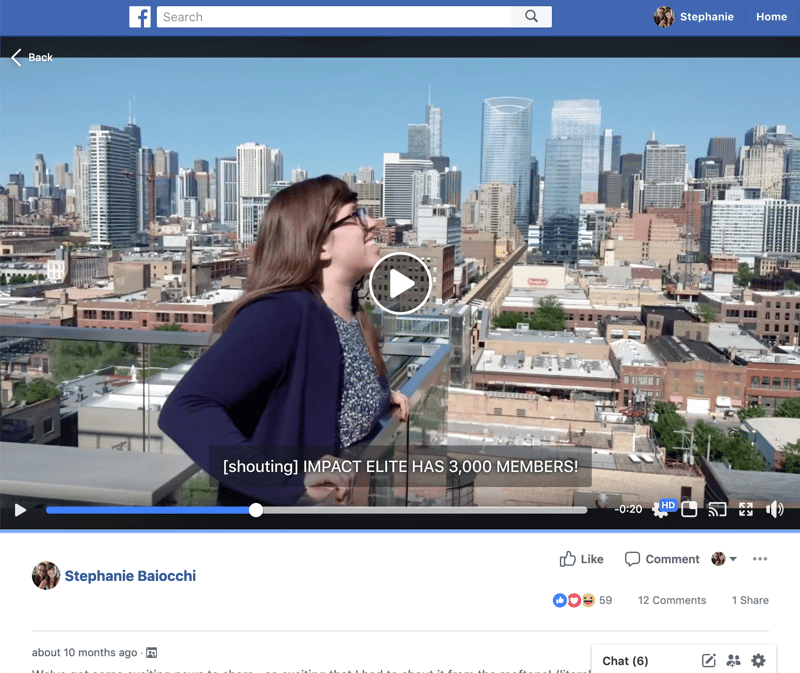
Live video specifically can be a great way to interact with your community because it allows them to have a discussion with you in real time, almost face-to-face. You can make them feel special by shouting out to them during the broadcast and reading their comments out loud.
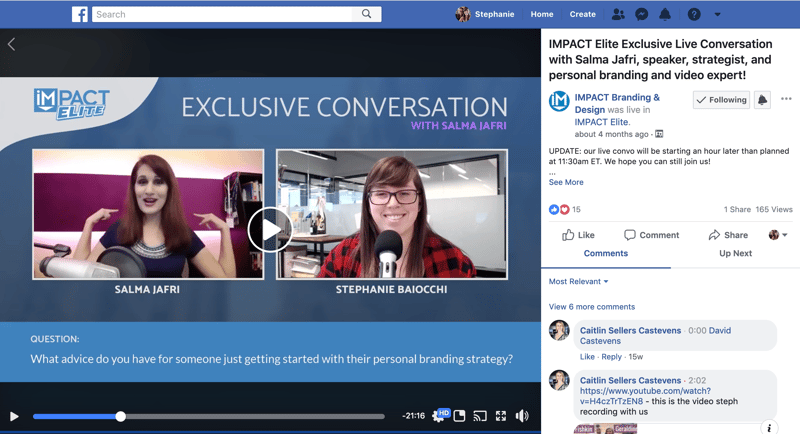
Just like how your community should be focused on a topic related to your brand and less on directly promoting your organization, the content you share should not be all yours either.
Sharing content that’s not written by your organization but still adds value to your group is a great way to show that you’re not just there to generate leads but that you actually want to share knowledge with your community and be helpful.
Plus, sharing content by members of the group will make them feel even more valued and encourage them to engage in conversation around their content.
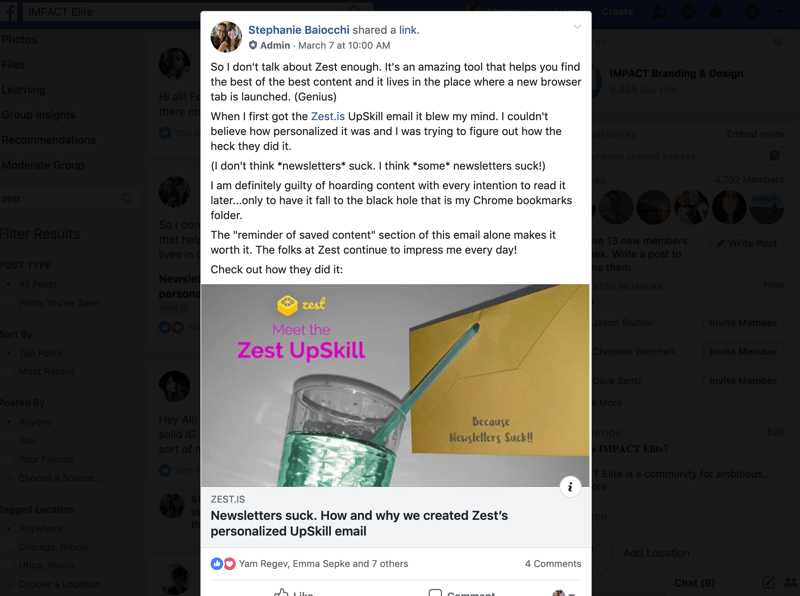
Chapter 9
As with many things in marketing and social media, it can be easy to fall into the trap of vanity metrics. What the real metrics are for your community, however, will depend on the mission and goals of your group.
Tracking member growth is important but rapid growth obviously doesn't translate into success.
I recommend setting goals around things like discussions started, replies on discussions, and engaged member rate. Other goals you can track include sales opportunities created via the community or pieces of content created from community discussions.
To get a better understanding of how online communities are measured I reached out to 14 online groups for marketers, across Slack and Facebook, that were around my group's size -- under 4,000 members at the time.
Here is what I learned:
I also asked how the community managers measure the success of their groups:

"When I took over the project, we didn't have Key Performance Indicators (KPIs) outlined, so I took some time to pull baseline analytics from Q4 of 2018 from Facebook. I'm a firm believer that you just need to put some type of goal in front of yourself with whatever information you have and then work from there to see if it's the right goal to track or if you need to focus on another metric. Not all metrics are the same.
From there, I set out to double the 2018 Q4 metrics for comments and reactions in Q1 of 2019 and to average 100 active users per day. These are tactical goals, but the true goal is much more nebulous. The goal has always been to foster a connection to other members and create a space for conversations and knowledge sharing."
The metrics you track when you first start your online community will be different as your group grows and evolves. Periodically, make it a point to evaluate your metrics as your group progresses to ensure you're still tracking what's the most relevant to your goals.
Chapter 10
When trying something new we all make mistakes.
Some mistakes are unavoidable and you'll learn from them. Other mistakes are completely preventable. What follows are those that are not only the most common but also totally preventable.
When you let even a single comment or question in your community go unnoticed it can appear as though you do not value the contributions of your members.
If a question isn't getting any replies, try asking some clarifying questions to get some more information. It's possible that people aren't replying because they simply don't understand the question or the question is too broad.
Sometimes, posts fall through the cracks because there are too many cooks in the kitchen, and everyone assumes someone else will take care of it. More often, it's because the person responsible is doing too many other things and dedicate enough time to the community.
For both of these reasons, it's important that you dedicate one main person to own your community and be ultimately responsible for it. This person needs dedicated time, resources, and support. They can delegate certain tasks to other team members or even community members but you need one main owner.
By this point, you should know your group is not about you.
Your online community is a resource for the members to get what you promised them in your group's mission statement. It is not to promote your services or products. Beware of slipping into being too self-serving.
Sometimes, I'll post in our community and realize there are two back to back posts from me without any other member posts in between. If this happens, I either remove my post and schedule it for later on or I make sure not to post again until at least a few other discussions have been started.
If a new member joins and they see three back to back posts from the admin of the group it can be a quick clue (even if it's inaccurate) that this group is not engaging and members do not interact much. That's not how you want to start off with a new member!
In fact, it may cause them to turn around and leave the group before ever engaging in it.
Once in a while, it might be okay to let a few things slide in your community. Maybe someone posts a job opening that's a great fit for your members, even though you have a rule against posting job openings in your group.
The problem with this is it's a slippery slope.
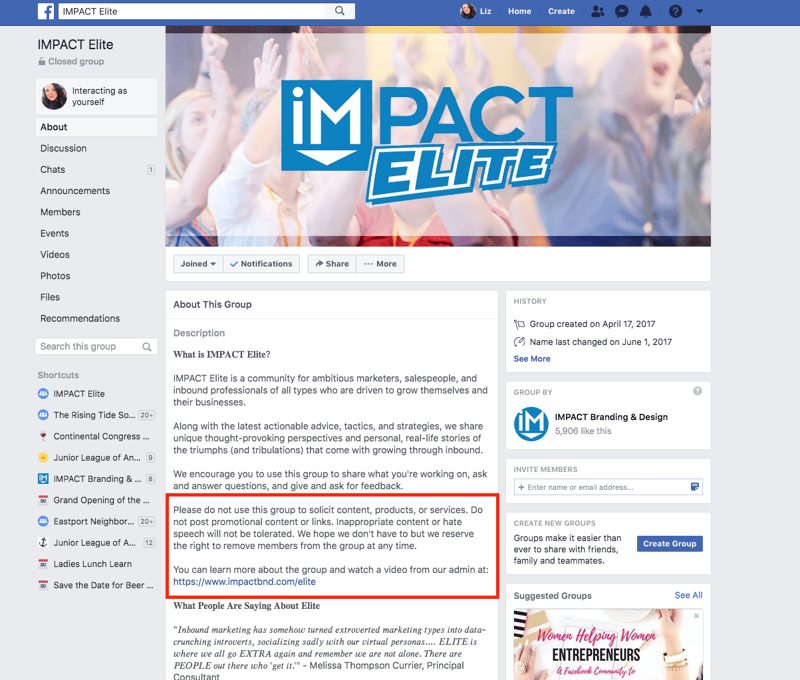
Once members see that it's OK, they'll begin doing the same. And it's much harder to deal with five posts that break the rules than just one.
Stick to your rules, even when it's hard.
If your community members continuously want to do something that goes against the rules, maybe it's time to consider creating a solution. For instance, you may want to start a weekly jobs thread where members can share open opportunities without cluttering up your group's feed with random job posts.
It might be tempting to automate your engagement on social networks with a bot that likes and comments on your behalf, but you'll get to a point where it starts to do more harm than good for your brand. In today's internet landscape -- which is just saturated with automation -- you need to prove there's a thinking and feeling human behind your brand to actually connect with customers.
In certain communities, however, automation is more common than others. For instance, in Slack it's more common for a bot to facilitate conversations than on Facebook:
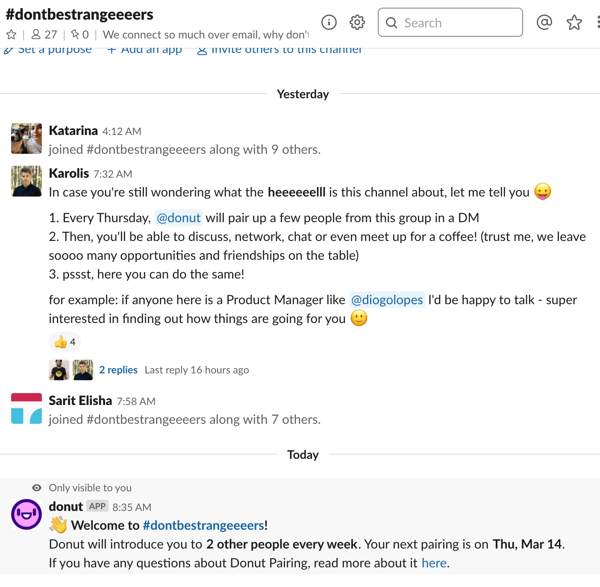
At IMPACT, we’ve built an amazing community of thousands of inbound professionals... and it lives on Facebook. We’ve talked many times as a team about both the risks and the rewards associated with building our community on Facebook.
Sure, the odds of Facebook disappearing completely tomorrow are quite low. However, even if just the Groups portion of Facebook was to go away, it would be a big deal for our community.
(I talked about this issue with Facebook in-depth in the section on where to build your community. It's just worth mentioning one more time.)
Traditions are an important part of online community management. They help keep members engaged and gives them a reason to come back. That said, your "traditions" will become instantly ineffective if you aren't consistent with them.
If you decide to do a personal promo thread on Mondays but miss one Monday, you can probably still recover. But if you miss more than once not only will your community start to lose interest they'll feel that you're not invested in them and will know they can't rely on you.
This is yet another slippery slope for your whole community.
The best community management advice I've ever heard -- and frankly, good advice for life in general -- is to avoid starting a conversation you cannot end.
If you see a conversation that requires your intervention, by all means, do what you have to do. However, there will always be people who just want to argue. Their goal is not to find common ground or compromise; their goal is to vent, period.
If you see that a conversation is getting out of control -- or even if you suspect it's moving in that direction -- it's truly OK to not engage. While I firmly believe every comment or post deserves your attention, sometimes your attention will have to come in the form of removing someone from your community.
Chapter 11
Despite our best efforts, there are just some things that are out of our control. Either they happen even if they've never happened before OR they're unavoidable and will happen no matter what. Either way, we can prepare.
Some of the most common issues you will most likely encounter at some point include member burnout, notification blindness, rule breakers, and complainers.
But what do you do?
You can have a great, engaging community going and all of a sudden the discussions lose momentum, new members show up less frequently, and everything starts to lose its energy.
Unfortunately, this is natural.
The first members of your community are usually very engaged in the beginning and are invested in helping your community become a success. Things are always exciting in the beginning! After some time goes by members may get comfortable and check in on the community less often.
Maybe the excitement of something new wears off. Perhaps, as more members join the group, they feel like it's less exclusive or that there are more people to answer potential questions. No matter the reason, members can become burnt out after some time.
One way to deal with member burnout is by rewarding your most dedicated members when they start to go quiet. If you notice someone isn't participating as much as they used to, find a way to bring them back and make them feel valued. We started highlighting our "member of the week." This was a nice way to remind the community of how much value our most dedicated members have added and to highlight them to the community.
Campaign Creators Director of Marketing and Community Manager Tammy Duggan-Herd also includes member features...
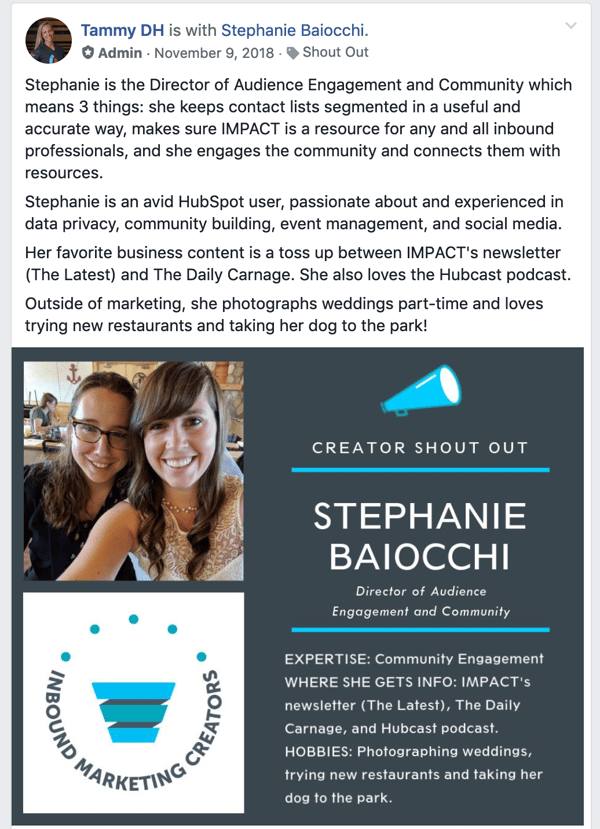
No matter where you build your community, the notifications about new community activity are competing with many other notifications. It might be Facebook notifications, Slack notifications, text messages, or simply all those other emails in someone's inbox.
Whether members start to ignore the notifications or they choose to turn them off entirely, this is the most common way groups lose momentum.
There are a few ways to combat notification blindness.
First, tagging people in conversations usually gets their attention and makes them feel needed in the community. Next, if you tag someone and they don't respond, take a screenshot or grab a link of where you tagged them and reach out directly letting them know you've called on them.
If your community is on Facebook and you encourage discussion in the community the posts will show up in users' feeds as well.
Beyond notifications, you can encourage your members to opt into an email list and send them updates about the community via email:

If you choose this route, make sure that the emails are adding value, or they'll get ignored just like the notifications.
Here's one thing you can count on -- someone, at some point, in your community will break the rules. In fact, multiple someones will.
Despite your best efforts to outline the rules clearly, have great welcome content that sets the tone for the group, and remind people often, rule-breakers will do what they do.
The best way to deal with rule breakers who are also great members of the community is to address it with them. Even if it's their first time posting it's worth trying to show them the error of their ways.
Take a moment to either comment publicly or message them directly and share why their post violates the rules and what they should have done instead. Make sure to give them clear direction on how to do better next time.
Chapter 12
Depending on where you build your community, there are some data privacy issues you need to be aware of. Respecting your community members' personal data is part of building and maintaining their trust.
While getting members to opt into an email list is a great way to keep them engaged and have a safety net when your community is built somewhere you can't control. Just keep GDPR and CAN SPAM laws in mind:

Video: How Privacy, Consent, & GDPR Will Impact the Future of Marketing (8 minutes)
Some groups choose to require an email opt-in to join. I don't recommend doing this as it's not linked to any GDPR compliant content and does not offer clear information about what users are opting into.
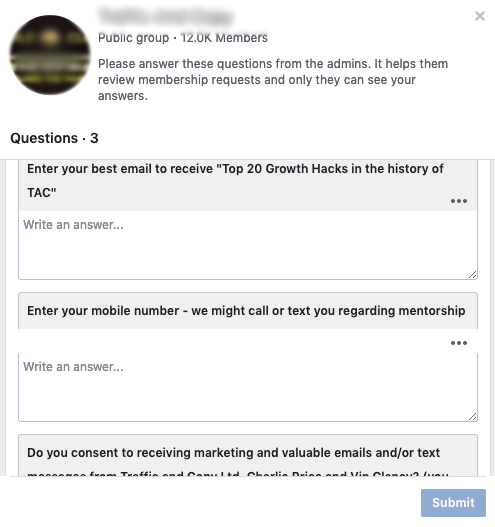
I know that this is a very short overview of what is an extremely complex topic.
But you should consider the above resources a starting point for you to dive into, so you can begin to familiarize yourself with the most pressing online community management data privacy and legal challenges.
Chapter 13
When you get your group running really smoothly it may be time to take the next step with your community. Some great next steps are launching an advocate community, hosting local in-person meetups, or putting on a live event...
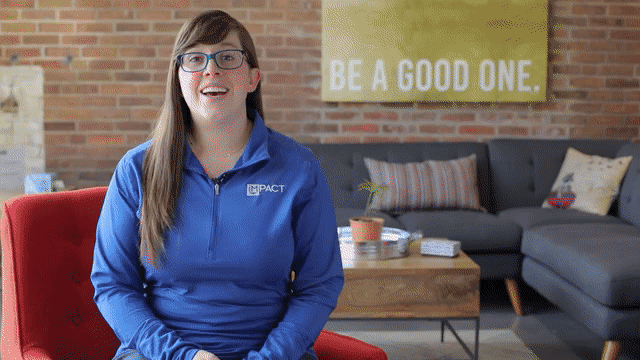
For example, we have IMPACT Insiders!
Of course, it's possible that your online community was created as a result of a live event. Or maybe it was created to connect users who are not located in close proximity and cannot attend in-person meetups.
Over time, you may start to see a few members stand out. Maybe they're super engaged in discussions or they are always willing to answer a question. This is a sign that you may be ready for an advocate community or affiliate program.
Stay tuned for more on this -- I've got a lot up my sleeve on this topic.
But until then, I'll see you in Elite!
We respond to requests immediately, so we’ll get back to you super fast to set up a time to chat.
Talk to us